
Leader in Targeted Protein Modulation Nurix Therapeutics Blazing a New Path in Medicine Investor Presentation January 2024 Exhibit 99.1
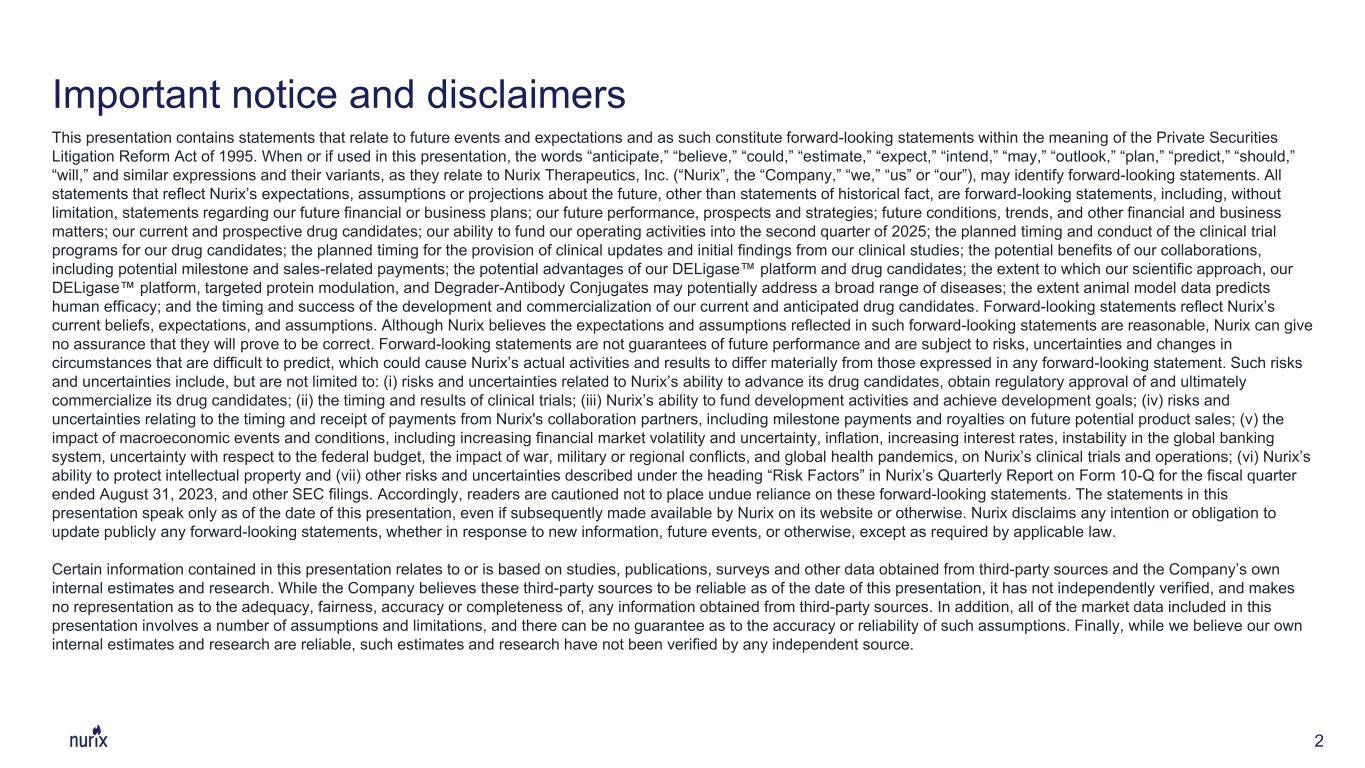
2 Important notice and disclaimers This presentation contains statements that relate to future events and expectations and as such constitute forward-looking statements within the meaning of the Private Securities Litigation Reform Act of 1995. When or if used in this presentation, the words “anticipate,” “believe,” “could,” “estimate,” “expect,” “intend,” “may,” “outlook,” “plan,” “predict,” “should,” “will,” and similar expressions and their variants, as they relate to Nurix Therapeutics, Inc. (“Nurix”, the “Company,” “we,” “us” or “our”), may identify forward-looking statements. All statements that reflect Nurix’s expectations, assumptions or projections about the future, other than statements of historical fact, are forward-looking statements, including, without limitation, statements regarding our future financial or business plans; our future performance, prospects and strategies; future conditions, trends, and other financial and business matters; our current and prospective drug candidates; our ability to fund our operating activities into the second quarter of 2025; the planned timing and conduct of the clinical trial programs for our drug candidates; the planned timing for the provision of clinical updates and initial findings from our clinical studies; the potential benefits of our collaborations, including potential milestone and sales-related payments; the potential advantages of our DELigase™ platform and drug candidates; the extent to which our scientific approach, our DELigase™ platform, targeted protein modulation, and Degrader-Antibody Conjugates may potentially address a broad range of diseases; the extent animal model data predicts human efficacy; and the timing and success of the development and commercialization of our current and anticipated drug candidates. Forward-looking statements reflect Nurix’s current beliefs, expectations, and assumptions. Although Nurix believes the expectations and assumptions reflected in such forward-looking statements are reasonable, Nurix can give no assurance that they will prove to be correct. Forward-looking statements are not guarantees of future performance and are subject to risks, uncertainties and changes in circumstances that are difficult to predict, which could cause Nurix’s actual activities and results to differ materially from those expressed in any forward-looking statement. Such risks and uncertainties include, but are not limited to: (i) risks and uncertainties related to Nurix’s ability to advance its drug candidates, obtain regulatory approval of and ultimately commercialize its drug candidates; (ii) the timing and results of clinical trials; (iii) Nurix’s ability to fund development activities and achieve development goals; (iv) risks and uncertainties relating to the timing and receipt of payments from Nurix's collaboration partners, including milestone payments and royalties on future potential product sales; (v) the impact of macroeconomic events and conditions, including increasing financial market volatility and uncertainty, inflation, increasing interest rates, instability in the global banking system, uncertainty with respect to the federal budget, the impact of war, military or regional conflicts, and global health pandemics, on Nurix’s clinical trials and operations; (vi) Nurix’s ability to protect intellectual property and (vii) other risks and uncertainties described under the heading “Risk Factors” in Nurix’s Quarterly Report on Form 10-Q for the fiscal quarter ended August 31, 2023, and other SEC filings. Accordingly, readers are cautioned not to place undue reliance on these forward-looking statements. The statements in this presentation speak only as of the date of this presentation, even if subsequently made available by Nurix on its website or otherwise. Nurix disclaims any intention or obligation to update publicly any forward-looking statements, whether in response to new information, future events, or otherwise, except as required by applicable law. Certain information contained in this presentation relates to or is based on studies, publications, surveys and other data obtained from third-party sources and the Company’s own internal estimates and research. While the Company believes these third-party sources to be reliable as of the date of this presentation, it has not independently verified, and makes no representation as to the adequacy, fairness, accuracy or completeness of, any information obtained from third-party sources. In addition, all of the market data included in this presentation involves a number of assumptions and limitations, and there can be no guarantee as to the accuracy or reliability of such assumptions. Finally, while we believe our own internal estimates and research are reliable, such estimates and research have not been verified by any independent source.

Targeted Protein Modulation: TPM = TPD + TPE Nurix Drugs Engage Ligases for the Treatment of Cancer Targeted Protein Degradation (TPD) Ubiquitin is ligated to target proteins to tag them for degradation by the proteasome Inhibit ligases to increase specific protein levels Harness ligases to decrease specific protein levels Targeted Protein Elevation (TPE) A Powerful Cellular System 3

• Led the field of BTK degraders demonstrating clinical efficacy across B-cell malignancies with the potential to displace BTK inhibitors by addressing drug resistance and scaffolding effects • Expanded therapeutic focus into inflammation & immunology with IRAK4 degrader licensed by Gilead and plans to enable NX-5948 development in autoimmune disease • Established first of its kind strategic collaboration with Seagen (now part of Pfizer) to advance an innovative new class of ADC cancer therapeutics called Degrader-Antibody Conjugates or DACs 4 Major Accomplishments by Nurix in 2023 Setting the stage for both near-term and long-term value creation
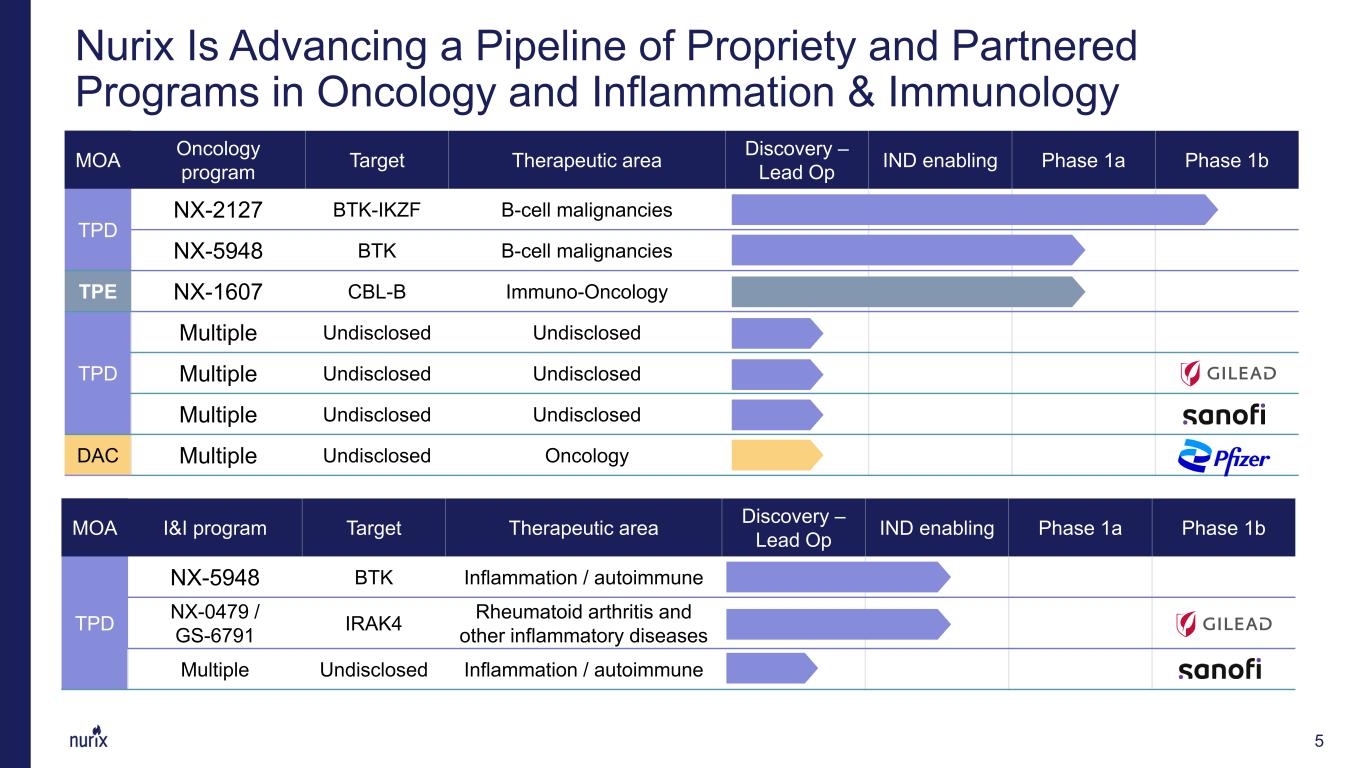
MOA Oncology program Target Therapeutic area Discovery – Lead Op IND enabling Phase 1a Phase 1b TPD NX-2127 BTK-IKZF B-cell malignancies NX-5948 BTK B-cell malignancies TPE NX-1607 CBL-B Immuno-Oncology TPD Multiple Undisclosed Undisclosed Multiple Undisclosed Undisclosed Multiple Undisclosed Undisclosed DAC Multiple Undisclosed Oncology Nurix Is Advancing a Pipeline of Propriety and Partnered Programs in Oncology and Inflammation & Immunology 5 MOA I&I program Target Therapeutic area Discovery – Lead Op IND enabling Phase 1a Phase 1b TPD NX-5948 BTK Inflammation / autoimmune NX-0479 / GS-6791 IRAK4 Rheumatoid arthritis and other inflammatory diseases Multiple Undisclosed Inflammation / autoimmune
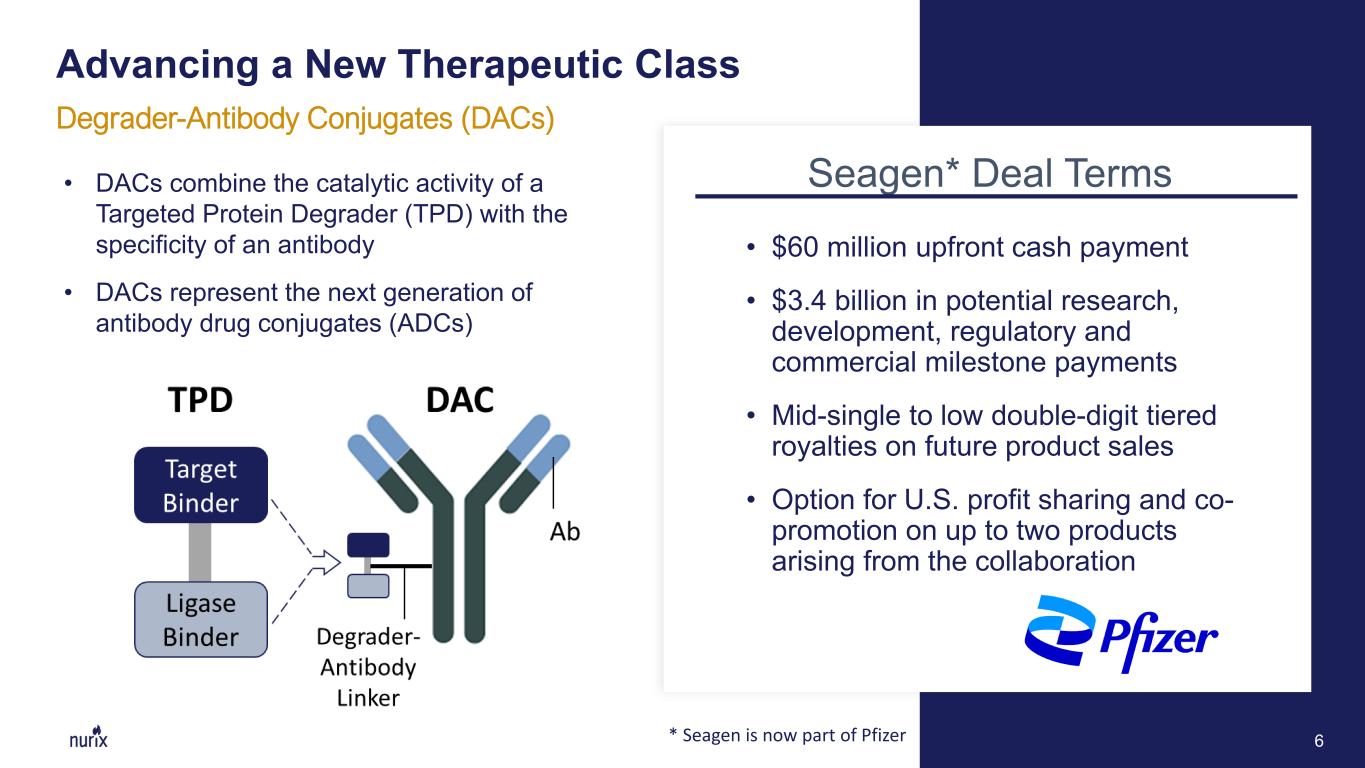
Advancing a New Therapeutic Class Degrader-Antibody Conjugates (DACs) 6 • DACs combine the catalytic activity of a Targeted Protein Degrader (TPD) with the specificity of an antibody • DACs represent the next generation of antibody drug conjugates (ADCs) • $60 million upfront cash payment • $3.4 billion in potential research, development, regulatory and commercial milestone payments • Mid-single to low double-digit tiered royalties on future product sales • Option for U.S. profit sharing and co- promotion on up to two products arising from the collaboration Seagen* Deal Terms * Seagen is now part of Pfizer

7 Targeted Protein Degradation Harnessing the ubiquitin proteosome system to eliminate disease proteins Ubiquitin BTK Ubiquitination of Protein BTK Destroyed by the Proteasome Degrader recycling Cereblon E3 Ligase Complex BTK Poly Ubiquitinated Proteins E2 Nurix degrader drugs BTK NX-5948 MOA
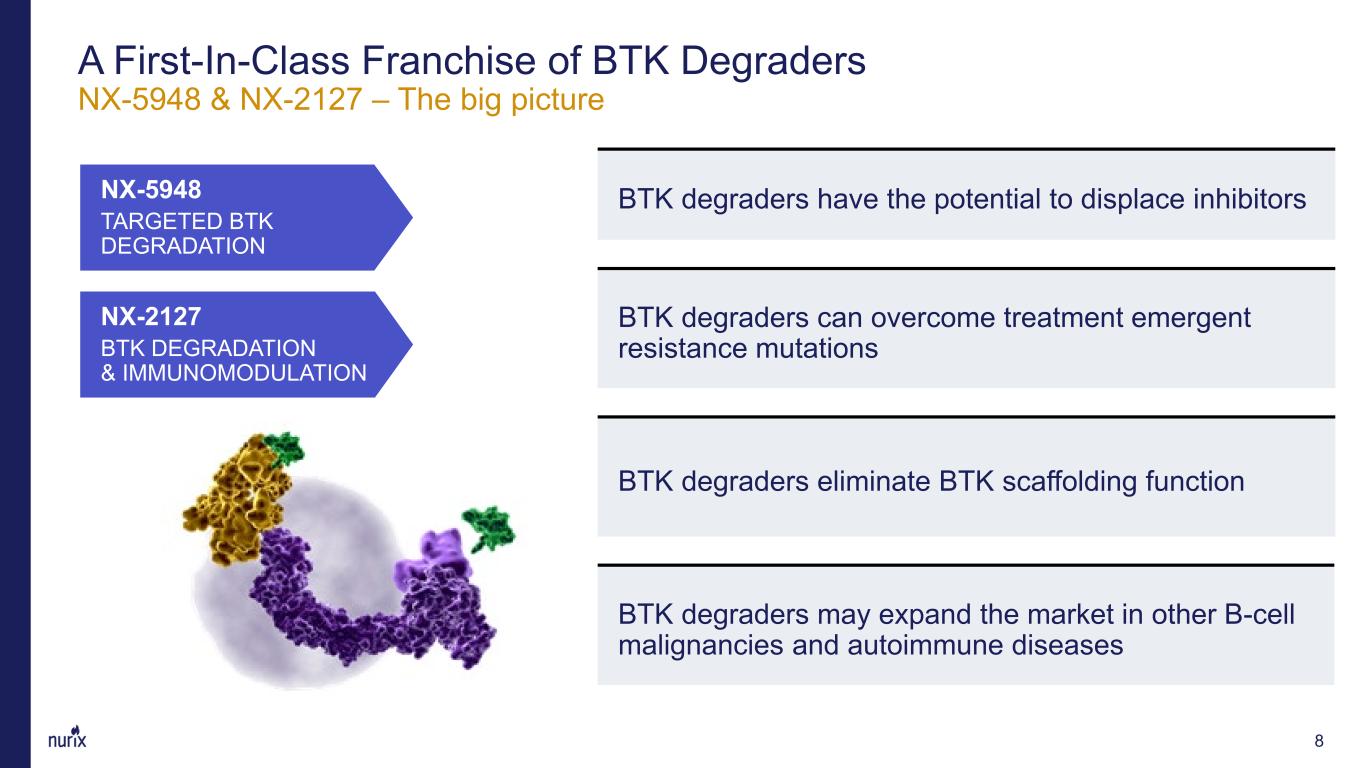
A First-In-Class Franchise of BTK Degraders NX-5948 & NX-2127 – The big picture 8 BTK degraders can overcome treatment emergent resistance mutations BTK degraders have the potential to displace inhibitors BTK degraders may expand the market in other B-cell malignancies and autoimmune diseases NX-5948 TARGETED BTK DEGRADATION NX-2127 BTK DEGRADATION & IMMUNOMODULATION BTK degraders eliminate BTK scaffolding function
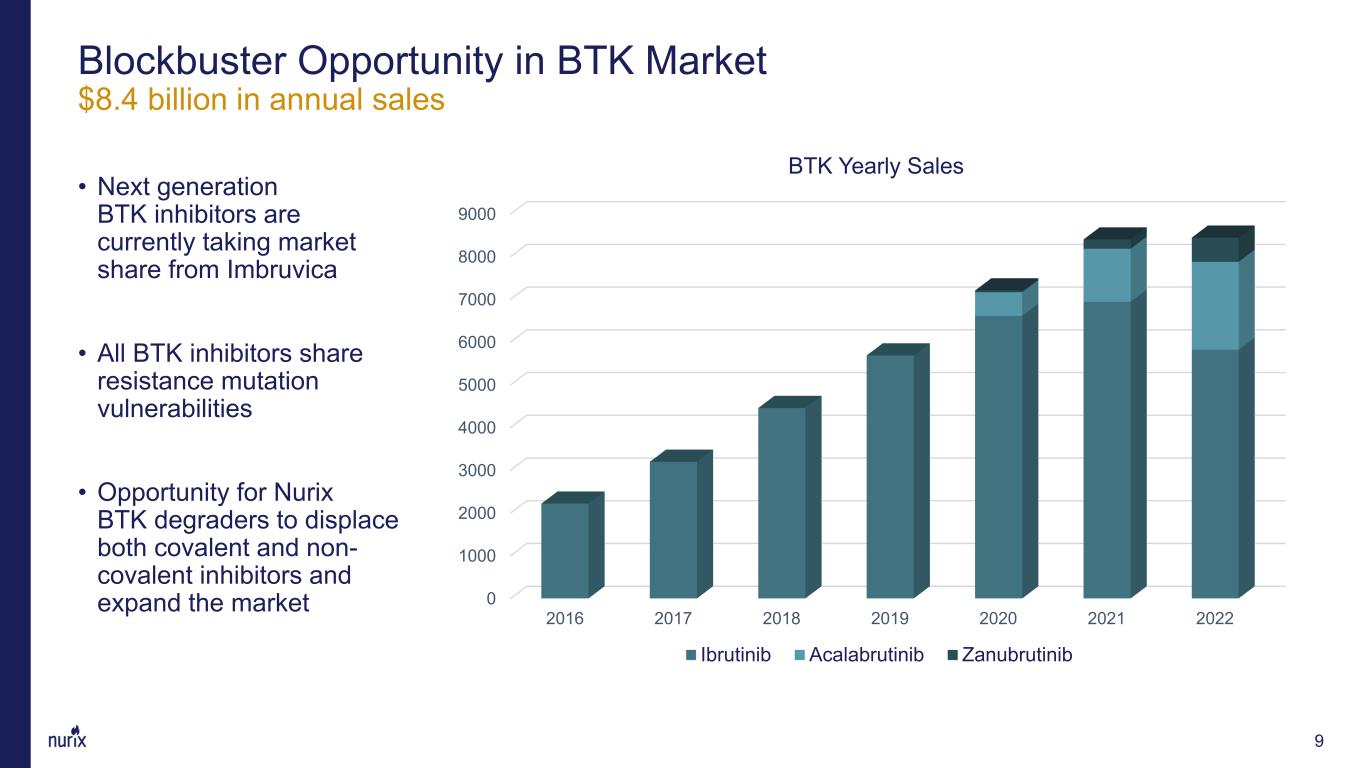
Blockbuster Opportunity in BTK Market $8.4 billion in annual sales 9 • Next generation BTK inhibitors are currently taking market share from Imbruvica • All BTK inhibitors share resistance mutation vulnerabilities • Opportunity for Nurix BTK degraders to displace both covalent and non- covalent inhibitors and expand the market 0 1000 2000 3000 4000 5000 6000 7000 8000 9000 2016 2017 2018 2019 2020 2021 2022 BTK Yearly Sales Ibrutinib Acalabrutinib Zanubrutinib

1st Generation Covalent inhibitor Non-Covalent Inhibitors Next Generation Covalent inhibitors Degraders Evolution of BTK Targeted Therapies Resistance Is Futile Ibrutinib Zanubrutinib Acalabrutinib Pirtobrutinib NX-5948 NX-2127 10 Inhibitors share common resistance mutations
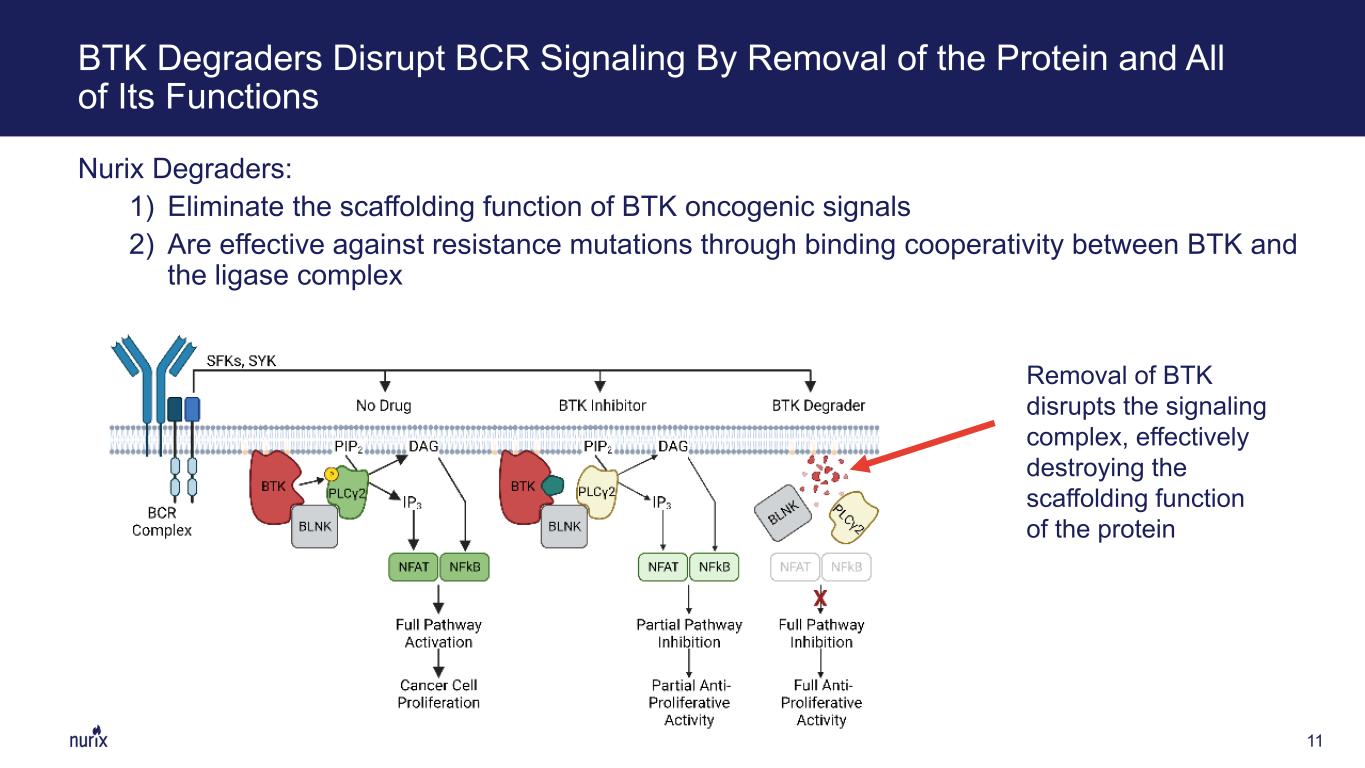
Nurix Degraders: 1) Eliminate the scaffolding function of BTK oncogenic signals 2) Are effective against resistance mutations through binding cooperativity between BTK and the ligase complex 11 BTK Degraders Disrupt BCR Signaling By Removal of the Protein and All of Its Functions Removal of BTK disrupts the signaling complex, effectively destroying the scaffolding function of the protein
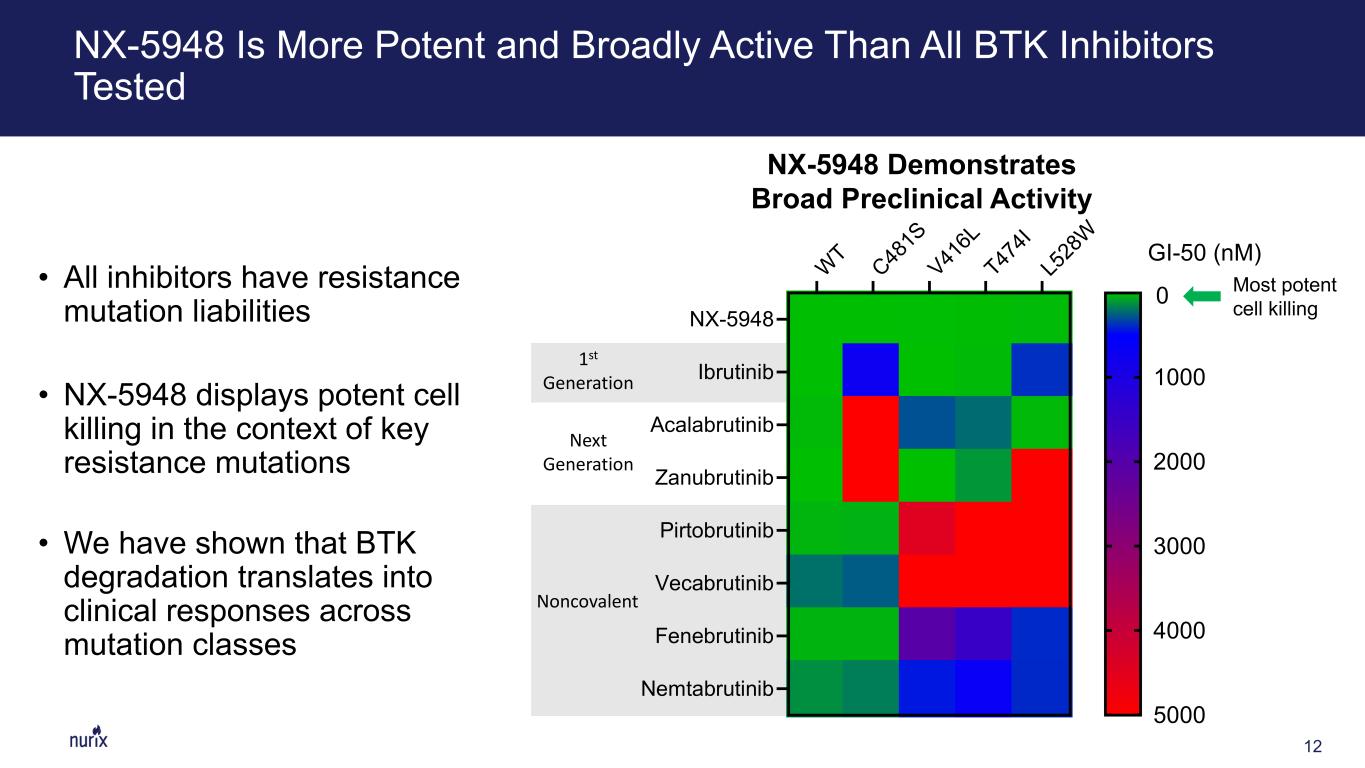
12 NX-5948 Is More Potent and Broadly Active Than All BTK Inhibitors Tested • All inhibitors have resistance mutation liabilities • NX-5948 displays potent cell killing in the context of key resistance mutations • We have shown that BTK degradation translates into clinical responses across mutation classes WT C48 1S V41 6L T47 4I L5 28 W NX-5948 Ibrutinib Acalabrutinib Zanubrutinib Pirtobrutinib Vecabrutinib Fenebrutinib Nemtabrutinib GI-50 (nM) 0 1000 2000 3000 4000 5000 Most potent cell killing NX-5948 Demonstrates Broad Preclinical Activity 1st Generation Noncovalent Next Generation
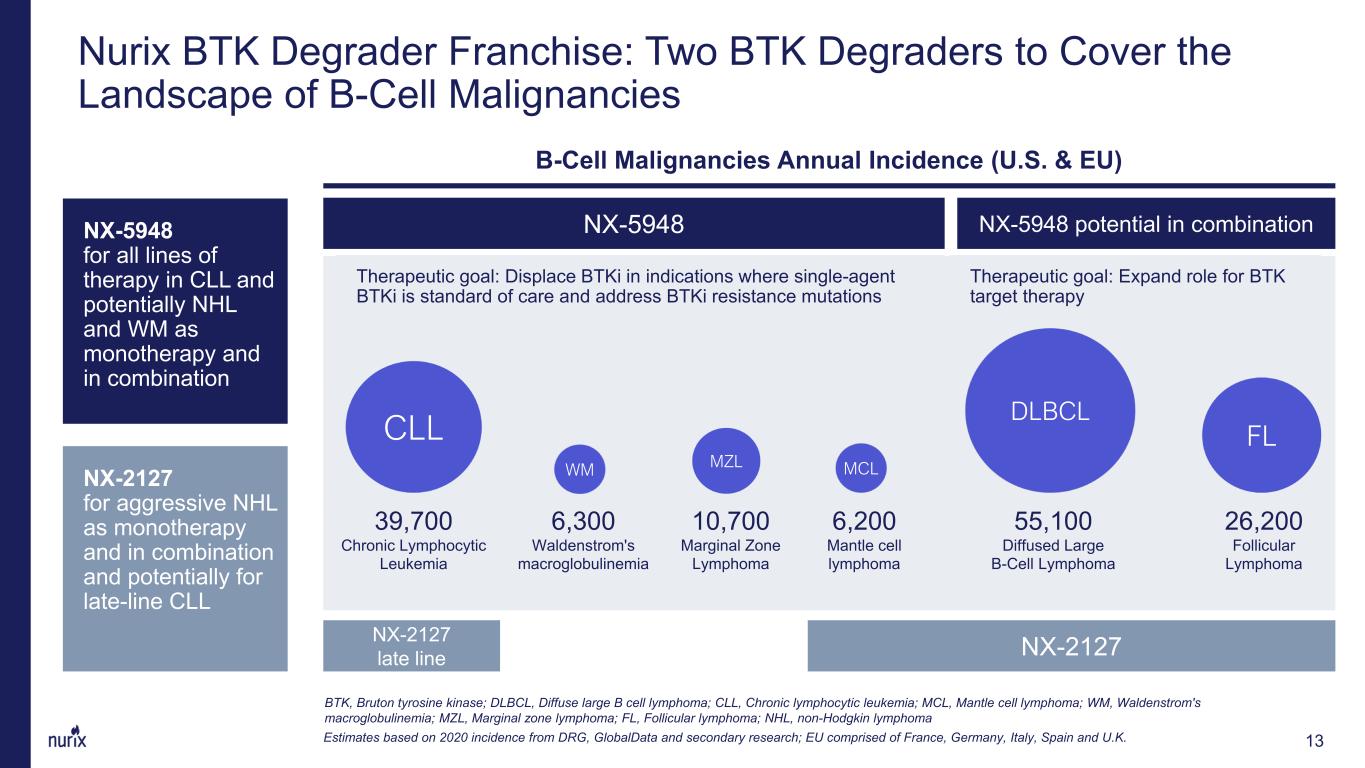
B-Cell Malignancies Annual Incidence (U.S. & EU) Nurix BTK Degrader Franchise: Two BTK Degraders to Cover the Landscape of B-Cell Malignancies BTK, Bruton tyrosine kinase; DLBCL, Diffuse large B cell lymphoma; CLL, Chronic lymphocytic leukemia; MCL, Mantle cell lymphoma; WM, Waldenstrom's macroglobulinemia; MZL, Marginal zone lymphoma; FL, Follicular lymphoma; NHL, non-Hodgkin lymphoma 13Estimates based on 2020 incidence from DRG, GlobalData and secondary research; EU comprised of France, Germany, Italy, Spain and U.K. DLBCL FL MZL CLL WM NX-5948 NX-2127NX-2127 late line NX-5948 potential in combination 39,700 Chronic Lymphocytic Leukemia 6,300 Waldenstrom's macroglobulinemia 10,700 Marginal Zone Lymphoma 55,100 Diffused Large B-Cell Lymphoma 26,200 Follicular Lymphoma NX-2127 for aggressive NHL as monotherapy and in combination and potentially for late-line CLL NX-5948 for all lines of therapy in CLL and potentially NHL and WM as monotherapy and in combination Therapeutic goal: Expand role for BTK target therapy Therapeutic goal: Displace BTKi in indications where single-agent BTKi is standard of care and address BTKi resistance mutations MCL 6,200 Mantle cell lymphoma

NX-5948-301: Trial Design Phase 1a/b trial in adults with relapsed/refractory B-cell malignancies aSubtypes include: transformed indolent lymphoma (e.g., grade 3b/transformed FL), Richter-transformed DLBCL, high-grade B-cell lymphoma with MYC and BCL-2 and/or BCL-6 rearrangements, high-grade B-cell lymphomas NOS; bIncludes patients with secondary CNS involvement; cAdditional lines of therapy include anthracycline for non-GCB DLBCL and BTKi for MCL Abbreviations: BCL-2i, B-cell lymphoma-2 inhibitor; BTKi, Bruton’s tyrosine kinase inhibitor; CIT, chemo-immunotherapy; CLL, chronic lymphocytic leukemia; CNS, central nervous system; DLBCL, diffuse large B-cell lymphoma; FL, follicular lymphoma; GCB, germinal center B-cell; L, level; MCL, mantle cell lymphoma; LoT, line of therapy; MZL, marginal zone lymphoma; NOS, not otherwise specified; PCNSL, primary central nervous system lymphoma; SLL, small lymphocytic lymphoma; WM, Waldenströms macroglobulinemia Phase 1a dose escalation B-cell malignancies, including CLL (N = up to 30 patients) Potential Phase 1b dose expansiona (N = up to 80 patients) CLL/SLL (n=20) Prior BTKi and BCL-2i DLBCLb,c or MCLc (n=20) Prior anti-CD20 CIT + 1 LoTd FLc, MZLc, WMc (n=20) ≥2 prior LoT PCNSL (n=20) Who have progressed or had no response to ≥2 prior LoT Dose L1 50 mg QD Dose L2 100 mg QD Dose L3 200 mg QD Dose L4 300 mg QD (Starting dose) Dose L5 450 mg QD Dose L6+ 600 mg QD 14 NHL/WM dose-escalation level as of ASH 2023 update CLL dose-escalation level as of ASH 2023 update
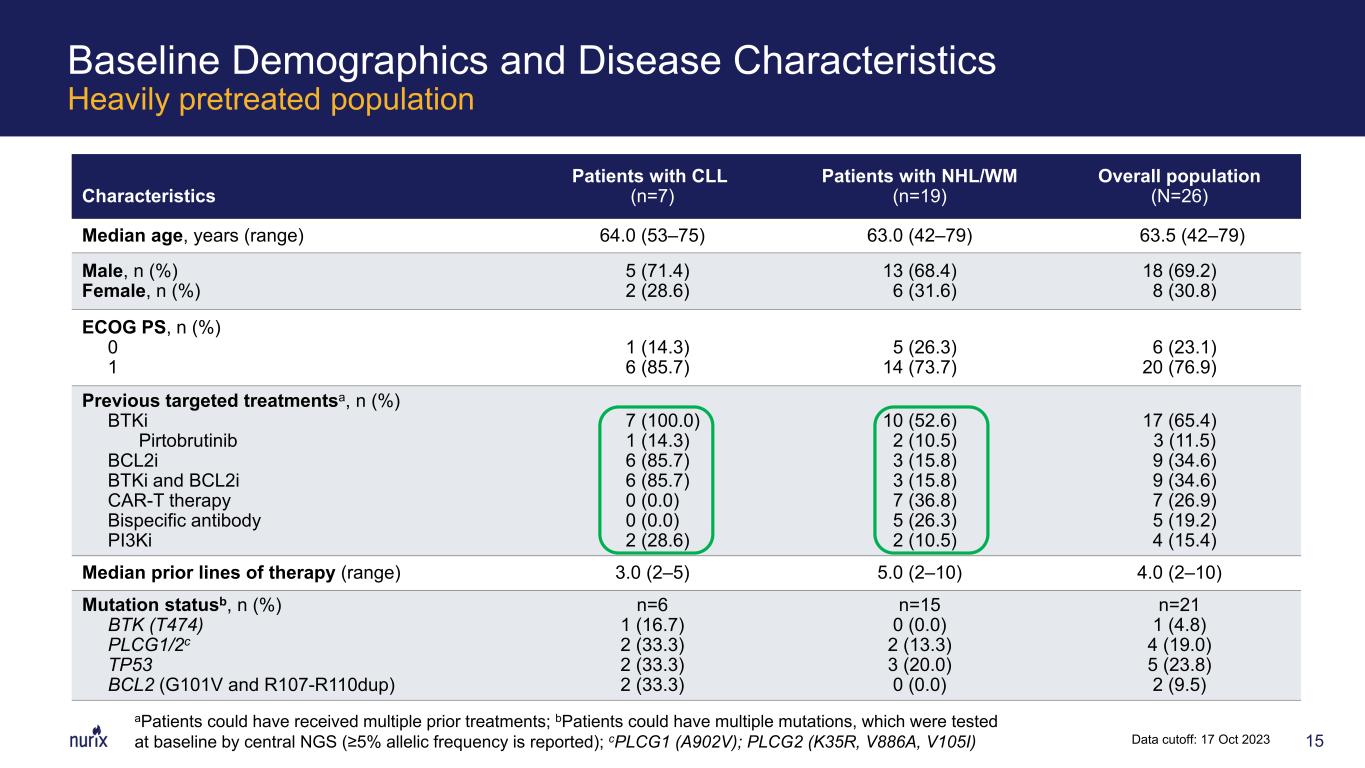
Baseline Demographics and Disease Characteristics Heavily pretreated population Characteristics Patients with CLL (n=7) Patients with NHL/WM (n=19) Overall population (N=26) Median age, years (range) 64.0 (53–75) 63.0 (42–79) 63.5 (42–79) Male, n (%) Female, n (%) 5 (71.4) 2 (28.6) 13 (68.4) 6 (31.6) 18 (69.2) 8 (30.8) ECOG PS, n (%) 0 1 1 (14.3) 6 (85.7) 5 (26.3) 14 (73.7) 6 (23.1) 20 (76.9) Previous targeted treatmentsa, n (%) BTKi Pirtobrutinib BCL2i BTKi and BCL2i CAR-T therapy Bispecific antibody PI3Ki 7 (100.0) 1 (14.3) 6 (85.7) 6 (85.7) 0 (0.0) 0 (0.0) 2 (28.6) 10 (52.6) 2 (10.5) 3 (15.8) 3 (15.8) 7 (36.8) 5 (26.3) 2 (10.5) 17 (65.4) 3 (11.5) 9 (34.6) 9 (34.6) 7 (26.9) 5 (19.2) 4 (15.4) Median prior lines of therapy (range) 3.0 (2–5) 5.0 (2–10) 4.0 (2–10) Mutation statusb, n (%) BTK (T474) PLCG1/2c TP53 BCL2 (G101V and R107-R110dup) n=6 1 (16.7) 2 (33.3) 2 (33.3) 2 (33.3) n=15 0 (0.0) 2 (13.3) 3 (20.0) 0 (0.0) n=21 1 (4.8) 4 (19.0) 5 (23.8) 2 (9.5) aPatients could have received multiple prior treatments; bPatients could have multiple mutations, which were tested at baseline by central NGS (≥5% allelic frequency is reported); cPLCG1 (A902V); PLCG2 (K35R, V886A, V105I) 15Data cutoff: 17 Oct 2023

• No atrial fibrillation/flutter or hypertension • No DLTs and no TEAEs resulting in drug discontinuation • Four NX-5948-related grade ≥3 TEAEs (3 neutropenia, 1 thrombocytopenia); no related serious adverse events aPurpura/contusion includes episodes of contusion or purpura; bAggregate of ‘thrombocytopenia’ and ‘platelet count decreased’; cAggregate of neutrophil count decreased or neutropenia TEAEs, n (%) Any grade Grade ≥3 SAEs Purpura/contusiona 12 (46.2) – – Thrombocytopeniab 10 (38.5) 2 (7.7) – Neutropeniac 8 (30.8) 5 (19.2) – Anemia 6 (23.1) 1 (3.8) – Cough 5 (19.2) – – Headache 5 (19.2) – – Nausea 5 (19.2) – – Rash 4 (15.4) – – COVID-19 3 (11.5) 2 (7.7) 2 (7.7) Pneumonia 2 (7.7) 2 (7.7) 2 (7.7) 16 NX-5948 Was Well Tolerated Frequency of TEAEs in ≥15% of patients or grade ≥3 or SAEs in >1 patient, (n=26) Data cutoff: 17 Oct 2023
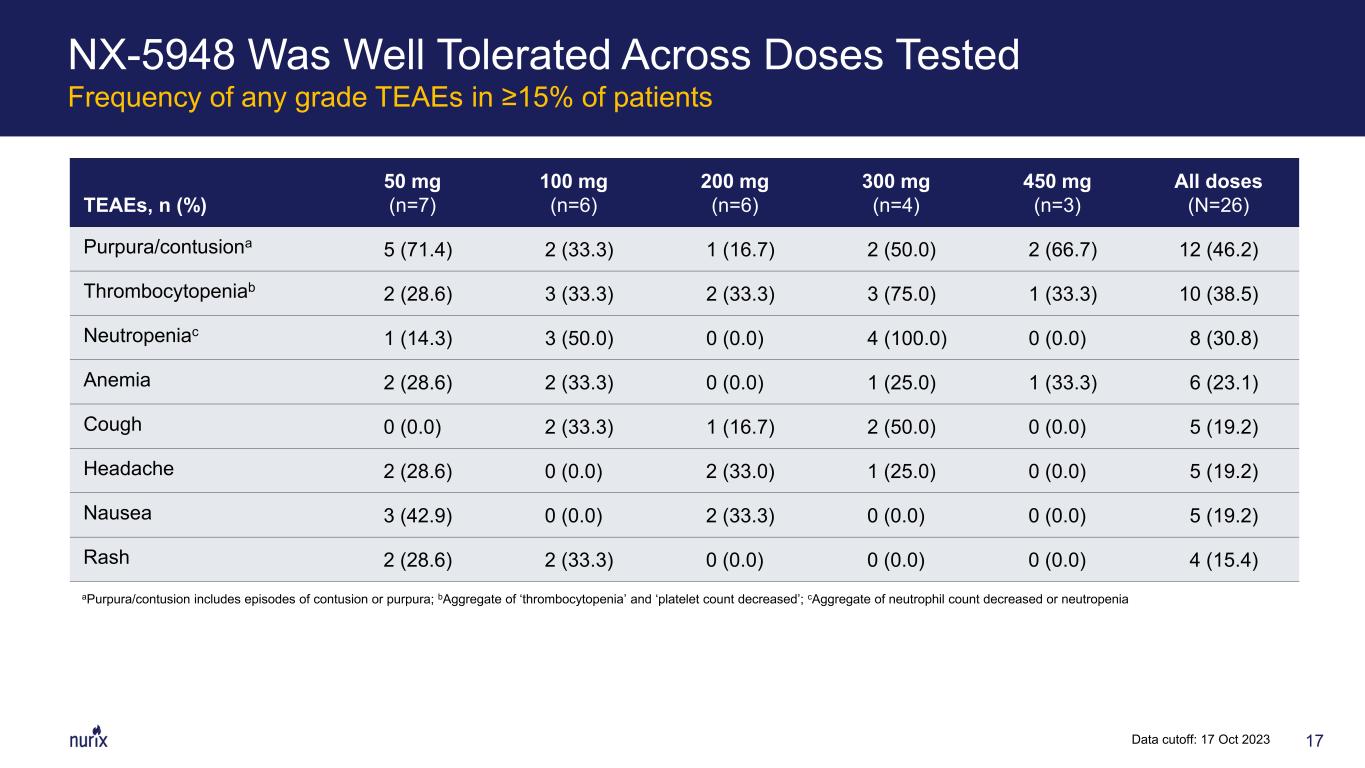
NX-5948 Was Well Tolerated Across Doses Tested Frequency of any grade TEAEs in ≥15% of patients TEAEs, n (%) 50 mg (n=7) 100 mg (n=6) 200 mg (n=6) 300 mg (n=4) 450 mg (n=3) All doses (N=26) Purpura/contusiona 5 (71.4) 2 (33.3) 1 (16.7) 2 (50.0) 2 (66.7) 12 (46.2) Thrombocytopeniab 2 (28.6) 3 (33.3) 2 (33.3) 3 (75.0) 1 (33.3) 10 (38.5) Neutropeniac 1 (14.3) 3 (50.0) 0 (0.0) 4 (100.0) 0 (0.0) 8 (30.8) Anemia 2 (28.6) 2 (33.3) 0 (0.0) 1 (25.0) 1 (33.3) 6 (23.1) Cough 0 (0.0) 2 (33.3) 1 (16.7) 2 (50.0) 0 (0.0) 5 (19.2) Headache 2 (28.6) 0 (0.0) 2 (33.0) 1 (25.0) 0 (0.0) 5 (19.2) Nausea 3 (42.9) 0 (0.0) 2 (33.3) 0 (0.0) 0 (0.0) 5 (19.2) Rash 2 (28.6) 2 (33.3) 0 (0.0) 0 (0.0) 0 (0.0) 4 (15.4) aPurpura/contusion includes episodes of contusion or purpura; bAggregate of ‘thrombocytopenia’ and ‘platelet count decreased’; cAggregate of neutrophil count decreased or neutropenia 17Data cutoff: 17 Oct 2023
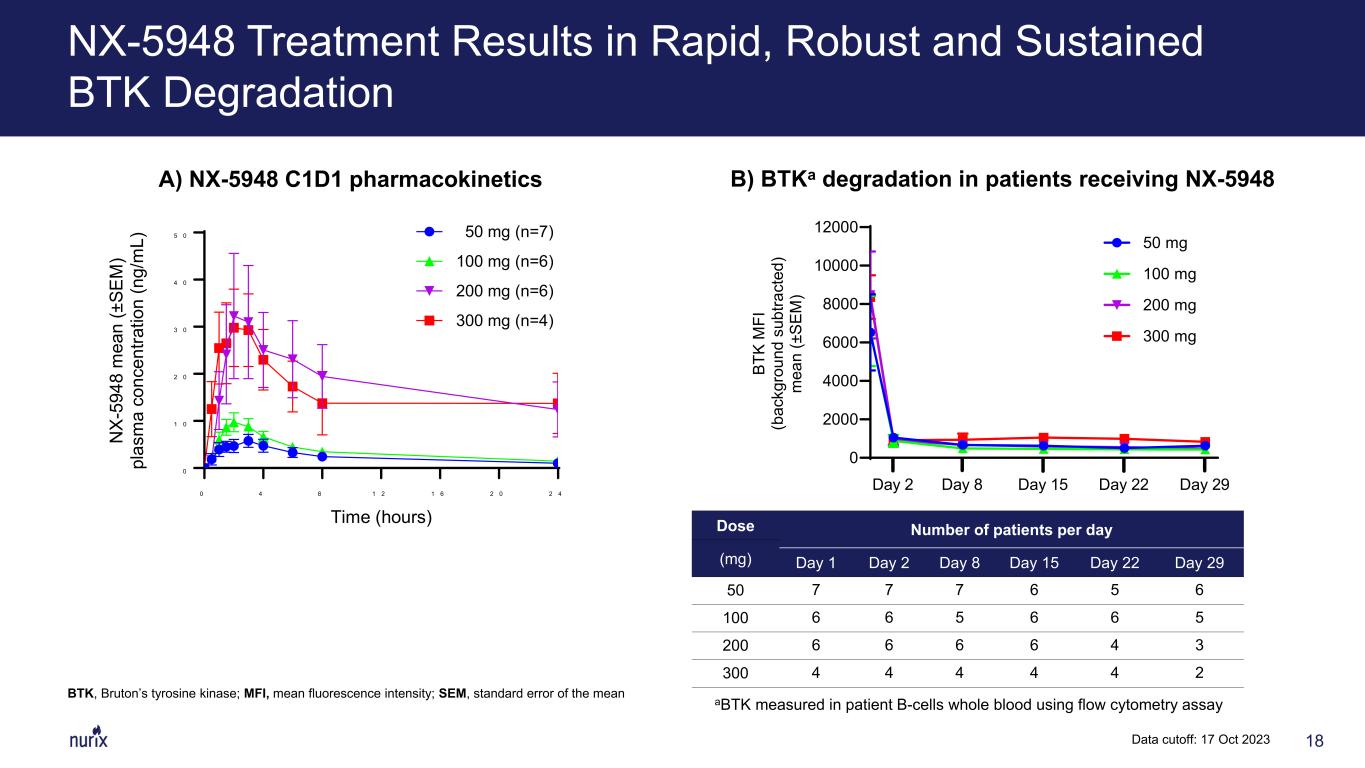
NX-5948 Treatment Results in Rapid, Robust and Sustained BTK Degradation Dose Number of patients per day (mg) Day 1 Day 2 Day 8 Day 15 Day 22 Day 29 50 7 7 7 6 5 6 100 6 6 5 6 6 5 200 6 6 6 6 4 3 300 4 4 4 4 4 2 BTK, Bruton’s tyrosine kinase; MFI, mean fluorescence intensity; SEM, standard error of the mean A) NX-5948 C1D1 pharmacokinetics 0 4 8 1 2 1 6 2 0 2 4 0 1 0 2 0 3 0 4 0 5 0 Time (hours) N X- 59 48 m ea n (± SE M ) pl as m a co nc en tra tio n (n g/ m L) 50 mg (n=7) 100 mg (n=6) 200 mg (n=6) 300 mg (n=4) 0 2000 4000 6000 8000 10000 12000 BT K M FI (b ac kg ro un d su bt ra ct ed ) m ea n (± SE M ) 50 mg 100 mg 200 mg Day 2 Day 15 Day 22 Day 29Day 8 300 mg aBTK measured in patient B-cells whole blood using flow cytometry assay B) BTKa degradation in patients receiving NX-5948 18Data cutoff: 17 Oct 2023
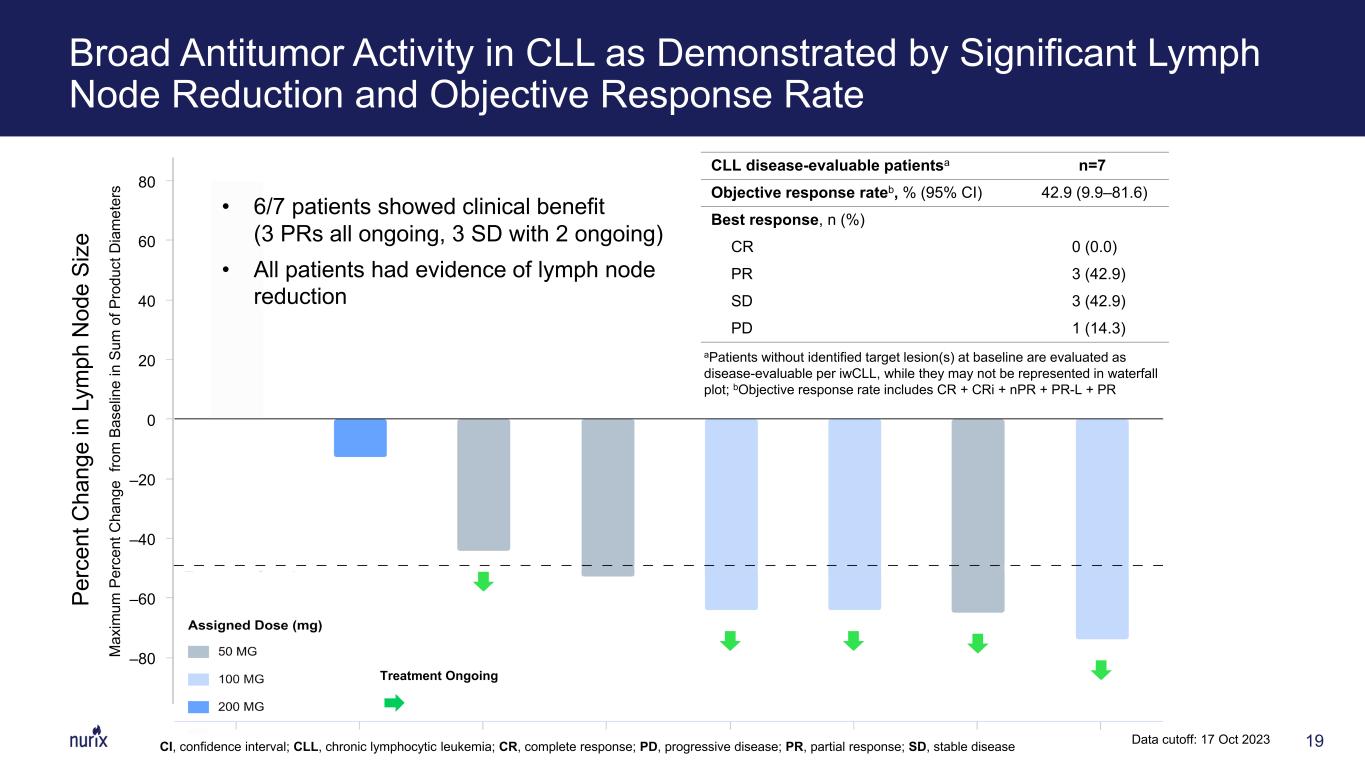
Broad Antitumor Activity in CLL as Demonstrated by Significant Lymph Node Reduction and Objective Response Rate 19 • 6/7 patients showed clinical benefit (3 PRs all ongoing, 3 SD with 2 ongoing) • All patients had evidence of lymph node reduction CLL disease-evaluable patientsa n=7 Objective response rateb, % (95% CI) 42.9 (9.9–81.6) Best response, n (%) CR 0 (0.0) PR 3 (42.9) SD 3 (42.9) PD 1 (14.3) aPatients without identified target lesion(s) at baseline are evaluated as disease-evaluable per iwCLL, while they may not be represented in waterfall plot; bObjective response rate includes CR + CRi + nPR + PR-L + PR Treatment Ongoing 80 60 40 20 0 –20 –40 –60 –80 Pe rc en t C ha ng e in L ym ph N od e Si ze M ax im um P er ce nt C ha ng e fr om B as el in e in S um o f P ro du ct D ia m et er s CI, confidence interval; CLL, chronic lymphocytic leukemia; CR, complete response; PD, progressive disease; PR, partial response; SD, stable disease Data cutoff: 17 Oct 2023
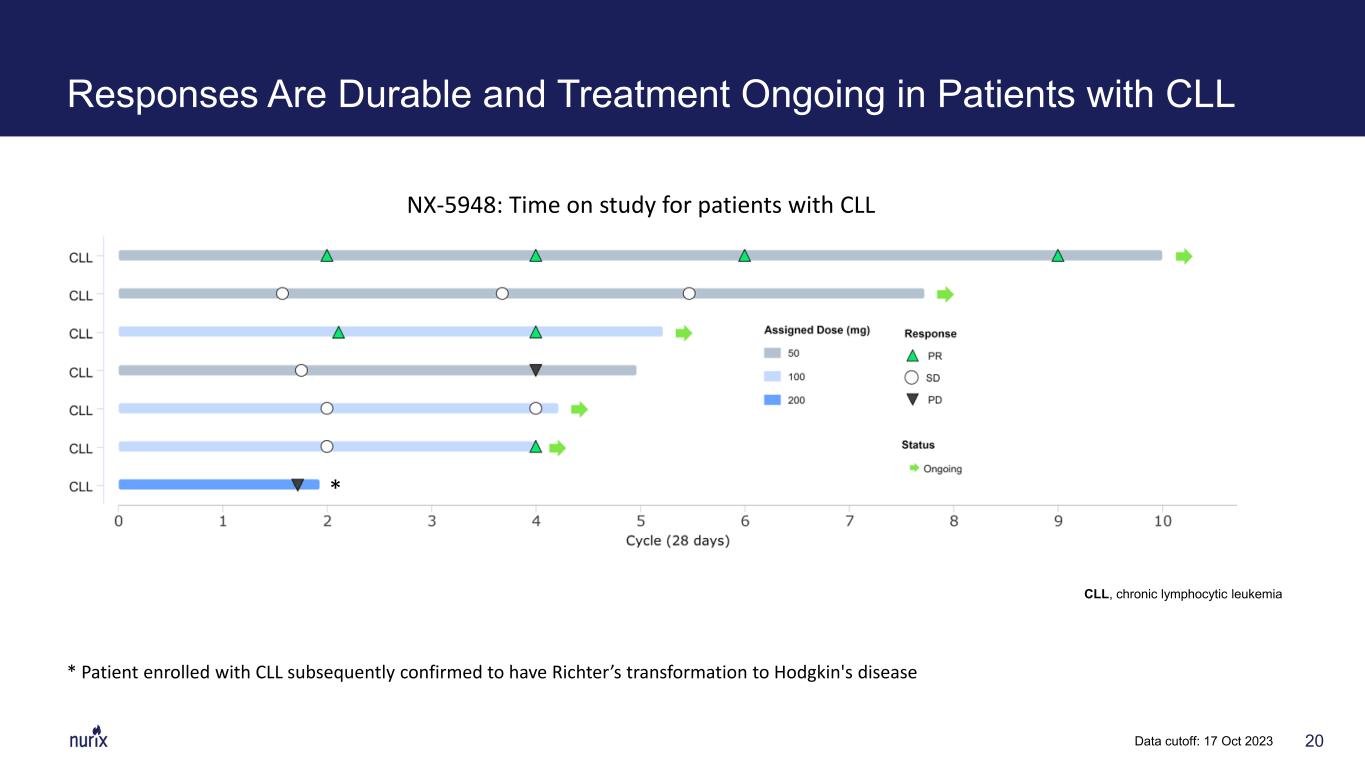
Responses Are Durable and Treatment Ongoing in Patients with CLL Data cutoff: 17 Oct 2023 20 CLL, chronic lymphocytic leukemia NX-5948: Time on study for patients with CLL * * Patient enrolled with CLL subsequently confirmed to have Richter’s transformation to Hodgkin's disease

0 20 40 60 80 260 -80 -60 -40 -20 M ax im um P er ce nt C ha ng e fro m B as el in e in S um o f P ro du ct D ia m et er s Assigned Dose (mg)Treatment Ongoing 50 100 200 300 MCL DLBCL PCNSL MCL MCL MZL DLBCL FL MCL MZL DLBCL Responses to NX-5948 Observed Across NHL Subtypes NHL/WM disease-evaluable patientsa n=14 Best response, n (%) CR 0 (0.0) PR/PMR 3 (21.4) SD 3 (21.4) PD 8 (57.1) aPatients without identified target lesion(s) at baseline are evaluated as disease-evaluable per Lugano and WM, while they may not be represented in waterfall plot 21 Activity observed across NHL subtypes CR, complete response; DLBCL, diffuse large B-cell lymphoma; FL, follicular lymphoma; MCL, mantle cell lymphoma; MZL, marginal zone lymphoma; NHL, non-Hodgkin’s lymphoma; PCNSL, primary CNS lymphoma; PD, progressive disease; PR, partial response; SD, stable disease; WM, Waldenstrom’s macroglobulinemia Data cutoff: 17 Oct 2023
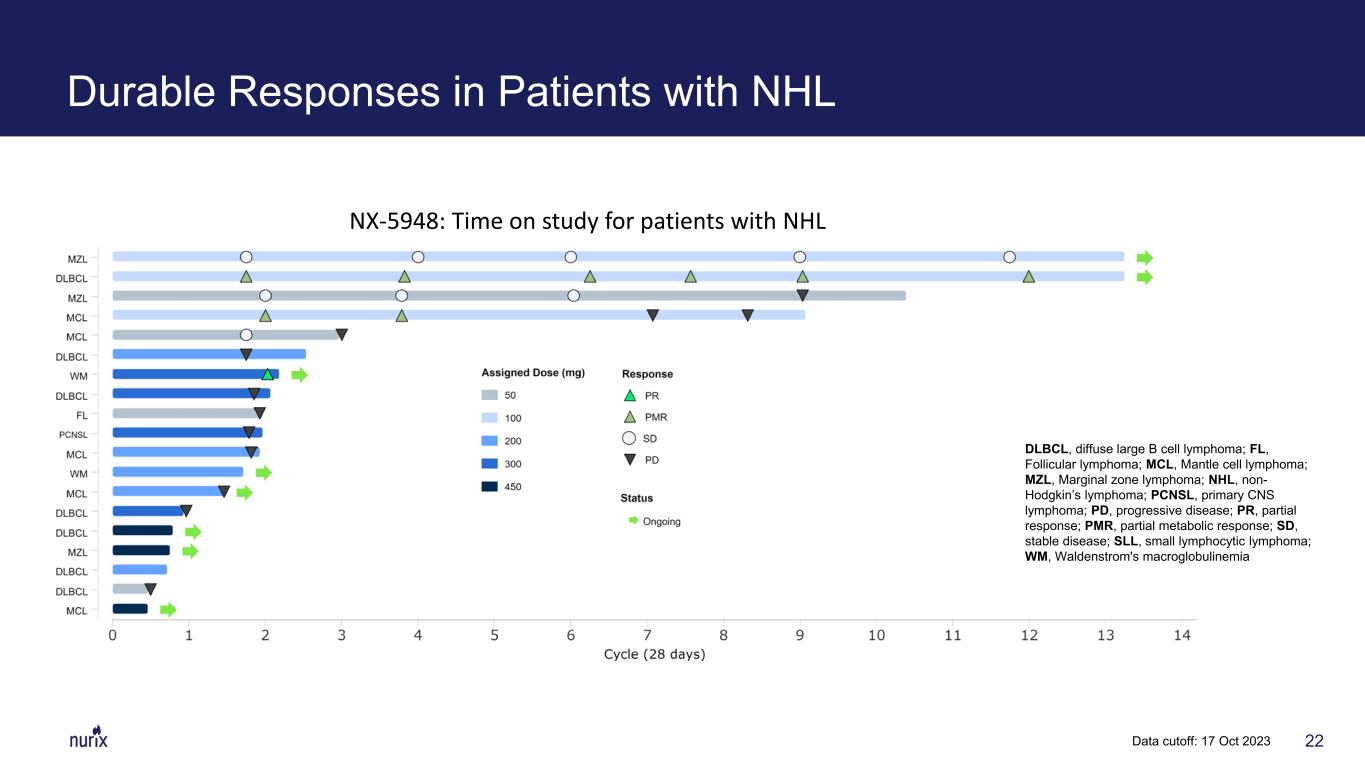
Durable Responses in Patients with NHL Data cutoff: 17 Oct 2023 22 NX-5948: Time on study for patients with NHL DLBCL, diffuse large B cell lymphoma; FL, Follicular lymphoma; MCL, Mantle cell lymphoma; MZL, Marginal zone lymphoma; NHL, non- Hodgkin’s lymphoma; PCNSL, primary CNS lymphoma; PD, progressive disease; PR, partial response; PMR, partial metabolic response; SD, stable disease; SLL, small lymphocytic lymphoma; WM, Waldenstrom's macroglobulinemia
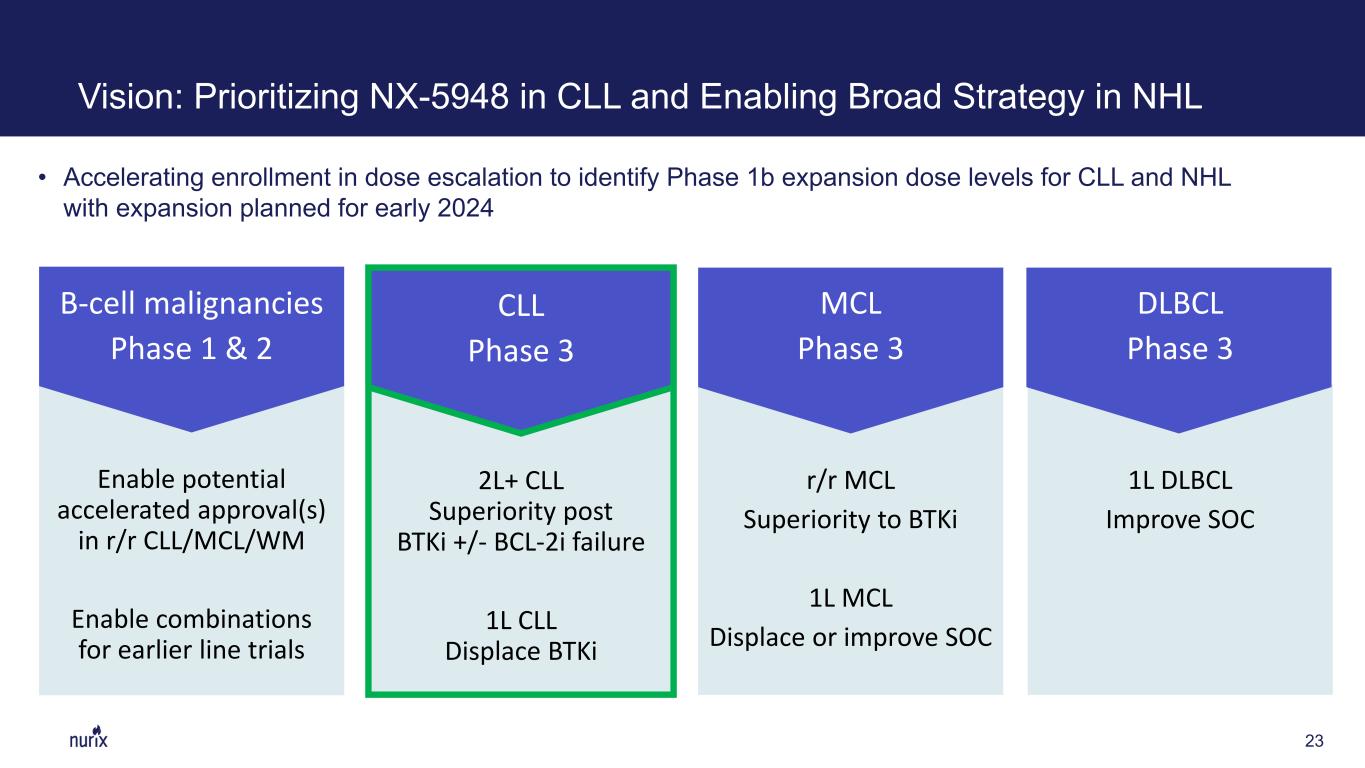
23 Vision: Prioritizing NX-5948 in CLL and Enabling Broad Strategy in NHL • Accelerating enrollment in dose escalation to identify Phase 1b expansion dose levels for CLL and NHL with expansion planned for early 2024 Enable potential accelerated approval(s) in r/r CLL/MCL/WM Enable combinations for earlier line trials 2L+ CLL Superiority post BTKi +/- BCL-2i failure 1L CLL Displace BTKi r/r MCL Superiority to BTKi 1L MCL Displace or improve SOC B-cell malignancies Phase 1 & 2 CLL Phase 3 MCL Phase 3 1L DLBCL Improve SOC DLBCL Phase 3

24 Beyond Hem/Onc: NX-5948 Is Highly Effective in Models of Major Inflammation & Immunology Indications 0 5 10 15 0 1 2 3 4 Rheumatoid Arthritis Model Days C lin ic al A rth rit is S co re * *** ******** Tx *p<0.05, **p < 0.01, ***, p < 0.001, ****p < 0.0001 compared to vehicle control Source: Rountree et al., 3rd B&T-cell Summit 2022 10 15 20 0 1 2 3 Multiple Sclerosis Model Days EA E Se ve rit y Sc or e **** Vehicle NX-5948 10 mg/kg NX-5948 30 mg/kg Ibrutinib 10 mg/kg Ibrutinib 30 mg/kg FTY720 3 mg/kg Plans to enable initiation of I&I development Extended preclinical toxicology Healthy volunteer study NX-5948 in Inflammation & Immunology

Oral daily dosing Phase 1a Accelerated titration / 3+3 escalation (n∼60a) CLL/SLL, MCL, DLBCL, FL, MZL, WM Phase 1b Select cohort expansionb CLL/SLL (100 mg) (n=40) MCL (300 mg) (n=20) DLBCL, WM (300 mg) (n=20)50 mg 100 mg 200 mg 300 mg CLL, chronic lymphocytic leukemia; DLBCL, diffuse large B-cell lymphoma; DLT, dose-limiting toxicity; FL, follicular lymphoma; MCL, mantle cell lymphoma; MTD, maximum tolerated dose; MZL, marginal zone lymphoma; PD, pharmacodynamics; PK, pharmacokinetics; PCNSL, primary central nervous system lymphoma; SLL, small lymphocytic lymphoma; WM, Waldenstrom's macroglobulinemia aPlanned number of evaluable patients (i.e., meeting DLT evaluability criteria); bPlanned number of evaluable patients (i.e., meeting efficacy evaluability criteria) • NX-2127-001 is a first-in- human, multicenter, U.S.- based, open-label, Phase 1 dose-escalation (Phase 1a) and cohort-expansion (Phase 1b) trial • Study is evaluating NX-2127 in adults with relapsed/refractory B-cell malignancies • Other potential expansion cohorts include patients with FL, MZL and PCNSL NX-2127-001: Trial Design Phase 1a/b trial in adults with relapsed/refractory B-cell malignancies 150 mg 25 Expansion dose for MCL & DLBCL Expansion dose for CLL

Baseline Demographics and Disease Characteristics Heavily pretreated population with significant acquired resistance mutations Characteristic CLL/SLL (n=33) NHL/WM (n=21) Overall population (N=54) Median age, years (range) 74.0 (58.0–90.0) 70.0 (50.0–92.0) 72.5 (50.0–92.0) Female, n (%) Male, n (%) 11 (33.3) 22 (66.7) 6 (28.6) 15 (71.4) 17 (31.5) 37 (68.5) ECOG PS, n (%) 0 1 18 (54.5) 15 (45.5) 10 (47.6) 11 (52.4) 28 (51.9) 26 (48.1) No. of lines of prior therapya, median (range) BTKi, n (%) Pirtobrutinib, n (%) BTKi and BCL2i, n (%) cBTKi, ncBTKi, and BCL2i, n (%) CAR-T/-NK therapy, n (%) Bispecific antibody, n (%) Immunomodulatory therapy (lenalidomide), n (%) 5 (2–11) 33 (100.0) 9 (27.3) 26 (78.8) 8 (24.2) 1 (3.0) 0 (0.0) 4 (12.1) 4 (2–10) 15 (71.4) 5 (23.8) 1 (4.8) 0 (0.0) 3 (14.3) 2 (9.5) 4 (19.0) 4 (2–11) 48 (88.9) 14 (25.9) 27 (50.0) 8 (14.8) 4 (7.4) 2 (3.7) 8 (14.8) aPatients could have multiple prior treatments 26Data cutoff: 15 Sept 2023
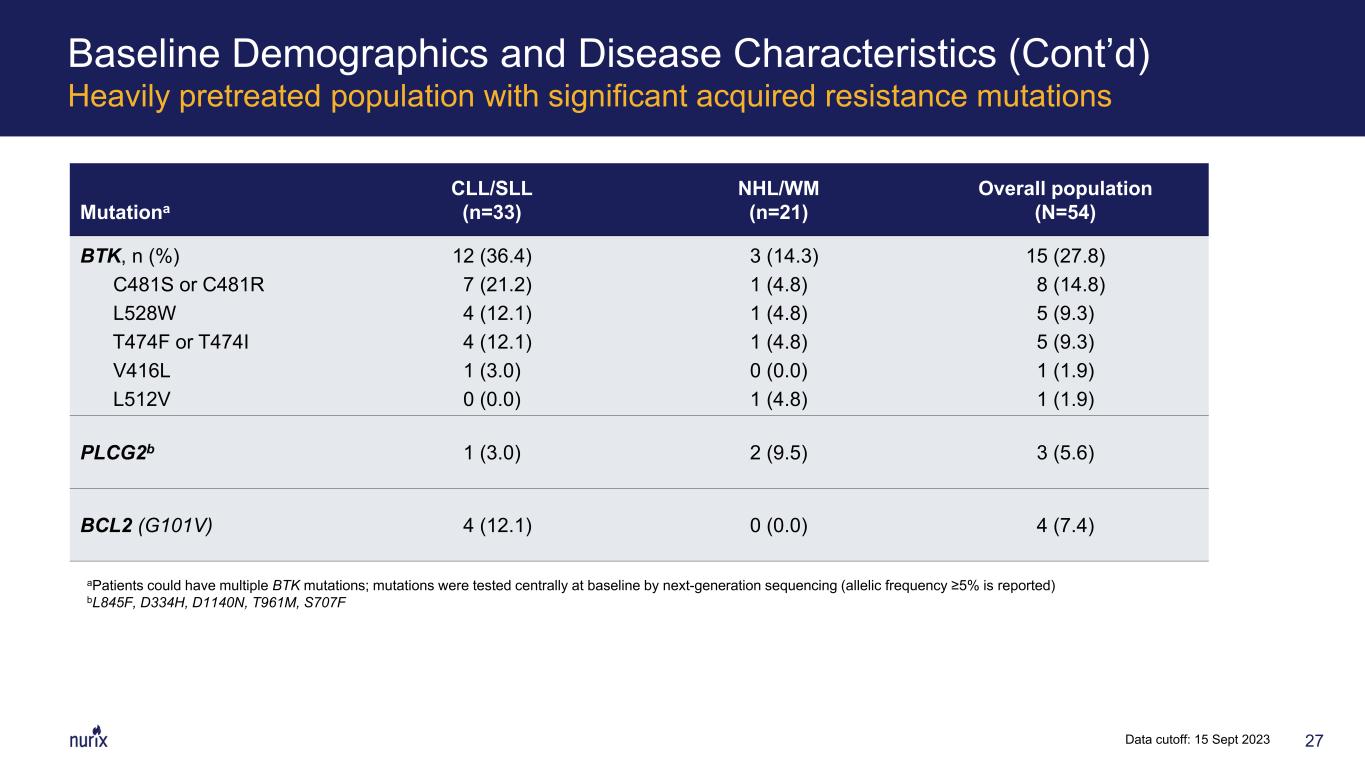
Baseline Demographics and Disease Characteristics (Cont’d) Heavily pretreated population with significant acquired resistance mutations aPatients could have multiple BTK mutations; mutations were tested centrally at baseline by next-generation sequencing (allelic frequency ≥5% is reported) bL845F, D334H, D1140N, T961M, S707F Mutationa CLL/SLL (n=33) NHL/WM (n=21) Overall population (N=54) BTK, n (%) C481S or C481R L528W T474F or T474I V416L L512V 12 (36.4) 7 (21.2) 4 (12.1) 4 (12.1) 1 (3.0) 0 (0.0) 3 (14.3) 1 (4.8) 1 (4.8) 1 (4.8) 0 (0.0) 1 (4.8) 15 (27.8) 8 (14.8) 5 (9.3) 5 (9.3) 1 (1.9) 1 (1.9) PLCG2b 1 (3.0) 2 (9.5) 3 (5.6) BCL2 (G101V) 4 (12.1) 0 (0.0) 4 (7.4) 27Data cutoff: 15 Sept 2023
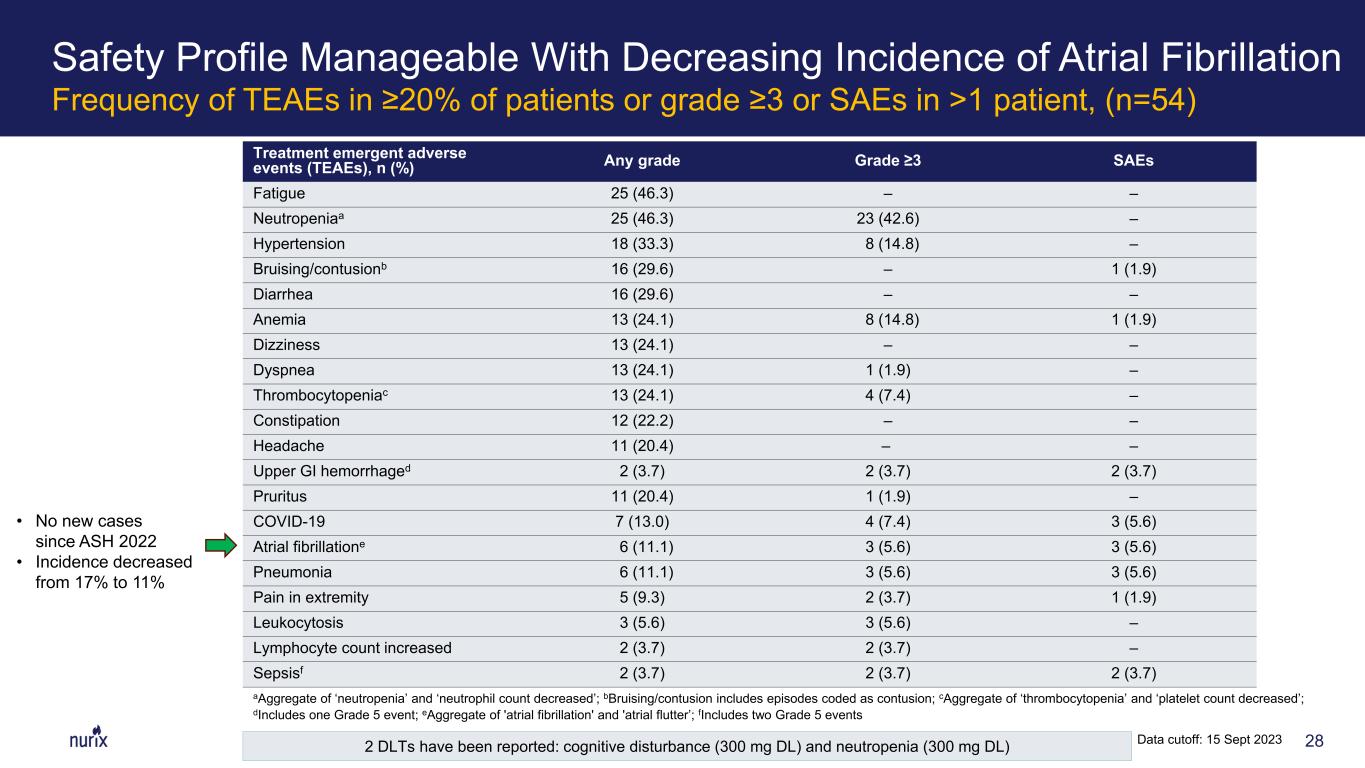
Safety Profile Manageable With Decreasing Incidence of Atrial Fibrillation Frequency of TEAEs in ≥20% of patients or grade ≥3 or SAEs in >1 patient, (n=54) aAggregate of ‘neutropenia’ and ‘neutrophil count decreased’; bBruising/contusion includes episodes coded as contusion; cAggregate of ‘thrombocytopenia’ and ‘platelet count decreased’; dIncludes one Grade 5 event; eAggregate of 'atrial fibrillation' and 'atrial flutter’; fIncludes two Grade 5 events Treatment emergent adverse events (TEAEs), n (%) Any grade Grade ≥3 SAEs Fatigue 25 (46.3) – – Neutropeniaa 25 (46.3) 23 (42.6) – Hypertension 18 (33.3) 8 (14.8) – Bruising/contusionb 16 (29.6) – 1 (1.9) Diarrhea 16 (29.6) – – Anemia 13 (24.1) 8 (14.8) 1 (1.9) Dizziness 13 (24.1) – – Dyspnea 13 (24.1) 1 (1.9) – Thrombocytopeniac 13 (24.1) 4 (7.4) – Constipation 12 (22.2) – – Headache 11 (20.4) – – Upper GI hemorrhaged 2 (3.7) 2 (3.7) 2 (3.7) Pruritus 11 (20.4) 1 (1.9) – COVID-19 7 (13.0) 4 (7.4) 3 (5.6) Atrial fibrillatione 6 (11.1) 3 (5.6) 3 (5.6) Pneumonia 6 (11.1) 3 (5.6) 3 (5.6) Pain in extremity 5 (9.3) 2 (3.7) 1 (1.9) Leukocytosis 3 (5.6) 3 (5.6) – Lymphocyte count increased 2 (3.7) 2 (3.7) – Sepsis f 2 (3.7) 2 (3.7) 2 (3.7) 2 DLTs have been reported: cognitive disturbance (300 mg DL) and neutropenia (300 mg DL) 28 • No new cases since ASH 2022 • Incidence decreased from 17% to 11% Data cutoff: 15 Sept 2023

B) BTKa degradation in patients receiving NX-2127A) NX-2127 C1D1 pharmacokinetics C) Ikarosb degradation in patients receiving NX-2127 NX-2127 Treatment Results in Rapid, Robust and Sustained BTK Degradation With Clinically Relevant Ikaros Degradation Dose (mg) Number of patients per day Day 0 Day 2 Day 8 Day 15 Day 22 Day 29 100 28 27 24 23 22 20 150 4 4 4 3 2 2 200 9 9 8 9 7 6 300 10 10 8 9 6* 4 aBTK measured in patient B-cells whole blood using flow cytometry assay; bIkaros measured in patient T-cells in PBMC using flow cytometry assay; c1 patient had dose modification from Day 19 onwards Dose (mg) Number of patients per day Day 0 Day 8 Day 29 100 23 19 16 200 5 5 4 300 5 4 3c 0 10 20 30 0 25 50 75 100 0 10 20 30 0 25 50 75 100 100 mg 200 mg 300 mg 0 10 20 30 0 25 50 75 100 T ce ll Ik ar os (% R em ai n) R el at iv e to C yc le 1 D ay 1 Time (days) 0 2 0 0 0 4 0 0 0 6 0 0 0 8 0 0 0 1 0 0 0 0 1 2 0 0 0 T i m e ( d a y s ) BT K M FI (b ac kg ro un d su bt ra ct ed ) m ea n (± SE M ) 2 8 15 22 29 200 mg 300 mg 100 mg 150 mg 0 4 8 1 2 1 6 2 0 2 4 0 5 1 0 1 5 2 0 T i m e ( h o u r s ) N X -2 12 7 m ea n (± S E M ) pl as m a co nc en tr at io n (n g/ m L) 100 mg (n=28) 150 mg (n=4) 200 mg (n=10) 300 mg (n=11) 29Data cutoff: 15 Sept 2023
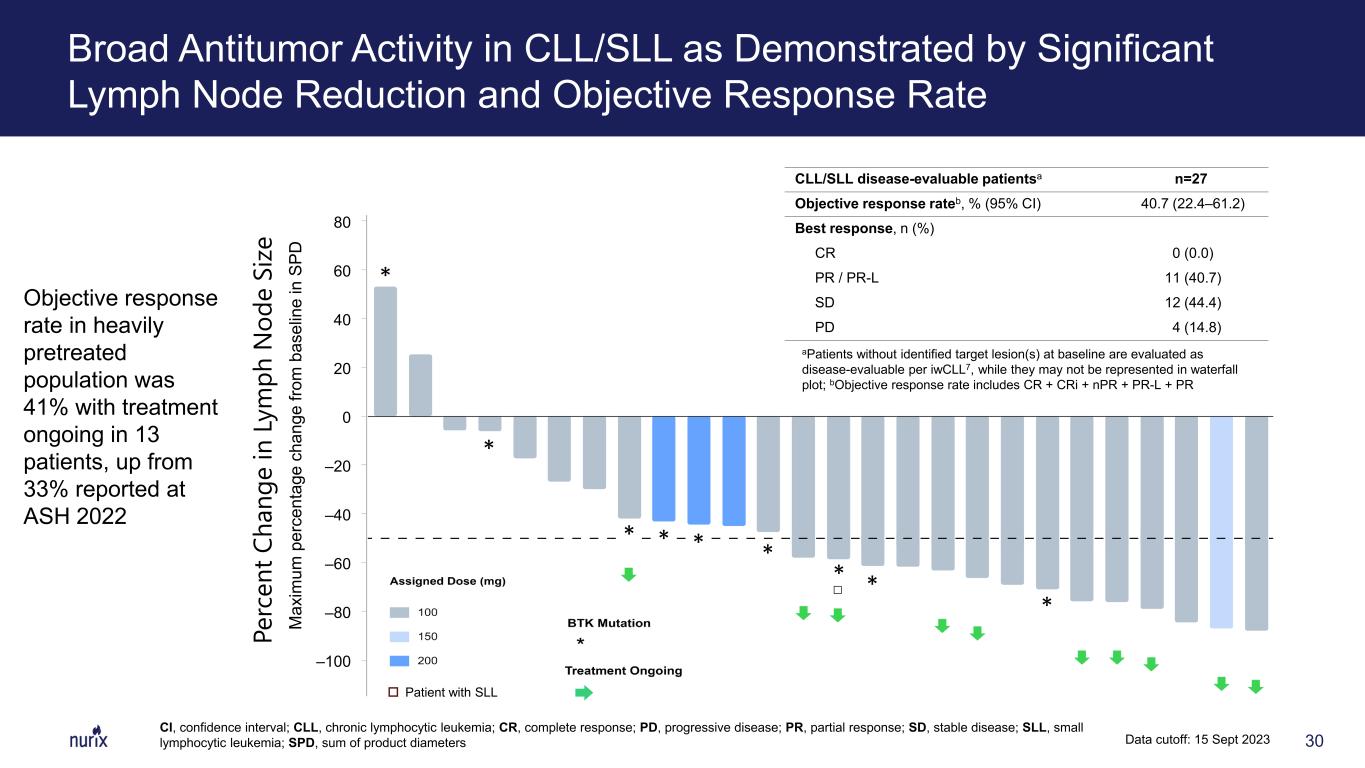
Broad Antitumor Activity in CLL/SLL as Demonstrated by Significant Lymph Node Reduction and Objective Response Rate CI, confidence interval; CLL, chronic lymphocytic leukemia; CR, complete response; PD, progressive disease; PR, partial response; SD, stable disease; SLL, small lymphocytic leukemia; SPD, sum of product diameters 30 BTK Mutation Treatment Ongoing Patient with SLL * □ * * ** □ **** * * M ax im um p er ce nt ag e ch an ge fr om b as el in e in S PD CLL/SLL disease-evaluable patientsa n=27 Objective response rateb, % (95% CI) 40.7 (22.4–61.2) Best response, n (%) CR 0 (0.0) PR / PR-L 11 (40.7) SD 12 (44.4) PD 4 (14.8) 80 60 40 20 0 –20 –40 –60 –80 –100 aPatients without identified target lesion(s) at baseline are evaluated as disease-evaluable per iwCLL7, while they may not be represented in waterfall plot; bObjective response rate includes CR + CRi + nPR + PR-L + PR Objective response rate in heavily pretreated population was 41% with treatment ongoing in 13 patients, up from 33% reported at ASH 2022 Pe rc en t C ha ng e in L ym ph N od e Si ze Patient with SLL Data cutoff: 15 Sept 2023

Durable Responses Seen in Heavily Pretreated CLL/SLL Patients 31 NX-2127 Time on study for CLL/SLL subjects * * * * * * * ** * * *□ BTK Mutation Treatment Ongoing Patient with SLL * □ Assigned Dose (mg) Response 100 150 200 300 PR PR-L SD PD NX-2127: Time on study for patients with CLL/SLL 0 1 2 3 4 5 6 7 8 9 10 11 12 13 14 15 16 17 18 19 20 21 22 23 Cycle (28 days) All patients had prior cBTKi Double exposed: Prior cBTKi and BCL2i Triple exposed: Prior cBTKi, ncBTKi, and BCL2i BCL2i, B-cell lymphoma-2 inhibitor; BTK, Bruton’s tyrosine kinase; cBTKi, covalent BTK inhibitor; ncBTKi, non- covalent BTK inhibitor; PD, progressive disease; Pirto, pirtobrunib; PR, partial response; PR-L, partial response with lymphocytosis; SD, stable disease Mutations were tested at baseline by NGS centrally Data cutoff: 15 Sept 2023

Responses Observed Across NHL Subtypes Including Rapid and Sustained Complete Responses CR, complete response; DLBCL, diffuse large B-cell lymphoma; FL, follicular lymphoma; MCL, mantle cell lymphoma; MZL, marginal zone lymphoma; NHL, non-Hodgkin’s lymphoma; PD, progressive disease; PR, partial response; SD, stable disease; WM, Waldenstrom’s macroglobulinemia 0 20 40 60 80 440 -80 -60 -40 -20 -100 Disease Type OngoingDLBCL FL MCL MZL WM SD SD PD PD PD PD SD SD CR CR PR PR M ax im um p er ce nt ag e ch an ge fr om b as el in e in S PD NHL/WM disease-evaluable patientsa n=17 Best response, n (%) CR 2 (11.8) PR 2 (11.8) SD 5 (29.4) PD 8 (47.1) aPatients without identified target lesion(s) at baseline are evaluated as disease- evaluable per Lugano and WM, while they may not be represented in waterfall plot 32 • Rapid CR at 8 weeks observed in 2 patients (DLBCL, MCL) with 15+ months durability • Rapid PRs at 8 weeks were observed in 2 patients (FL, MZL) Pe rc en t C ha ng e in L ym ph N od e Si ze Data cutoff: 15 Sept 2023

Ongoing Durable Complete Responses With Over One Year of Follow Up Seen in DLBCL and MCL 33BTKi, Bruton’s tyrosine kinase inhibitor; CR, complete response; DLBCL, diffuse large B-cell lymphoma; FL, follicular lymphoma; MCL, mantle cell lymphoma; MZL, marginal zone lymphoma; PD, progressive disease; PR, partial response; SD, stable disease; WM, Waldenstrom’s macroglobulinemia NX-2127 Time on study for CLL/SLL subjects Cycle (28 days) 0 1 2 3 4 5 6 7 8 9 10 11 12 13 14 15 16 17 18 19 NX-2127: Time on study for patients with NHL MCL MCL MCL MCL MCL MCL MCL DLBCL DLBCL DLBCL DLBCL DLBCL DLBCL WM WM WM FL FL MZL MZL MZL Data cutoff: 15 Sept 2023
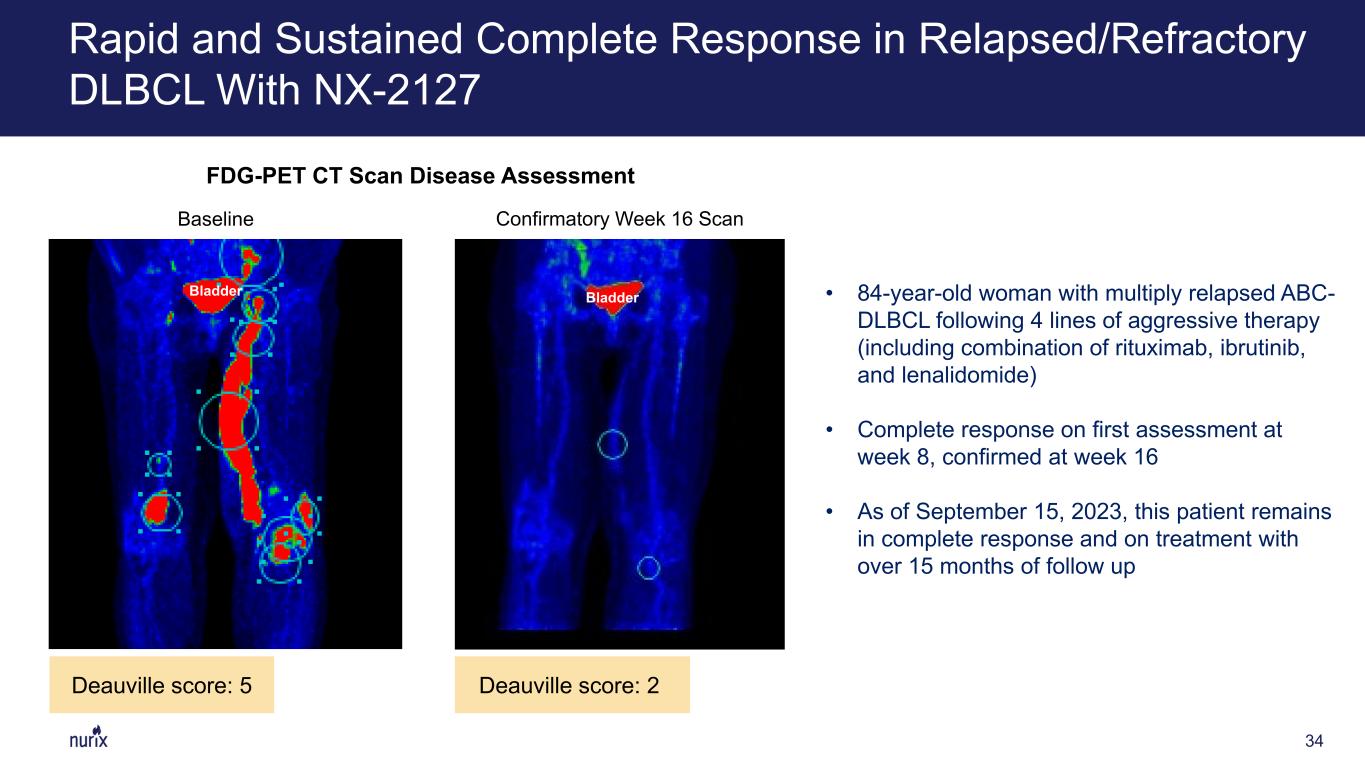
Rapid and Sustained Complete Response in Relapsed/Refractory DLBCL With NX-2127 34 Confirmatory Week 16 Scan Deauville score: 2 Baseline FDG-PET CT Scan Disease Assessment Deauville score: 5 Bladder Bladder • 84-year-old woman with multiply relapsed ABC- DLBCL following 4 lines of aggressive therapy (including combination of rituximab, ibrutinib, and lenalidomide) • Complete response on first assessment at week 8, confirmed at week 16 • As of September 15, 2023, this patient remains in complete response and on treatment with over 15 months of follow up
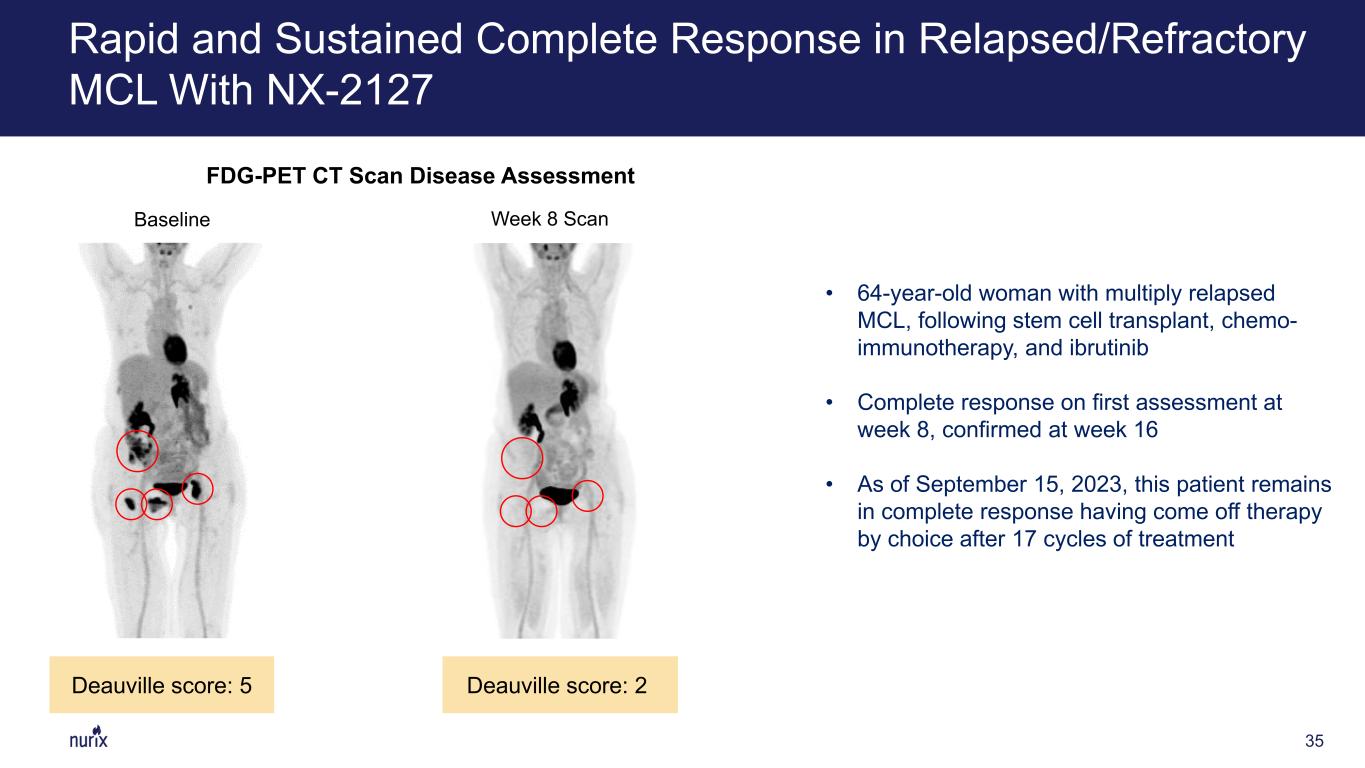
Rapid and Sustained Complete Response in Relapsed/Refractory MCL With NX-2127 35 Week 8 Scan Deauville score: 2 Baseline FDG-PET CT Scan Disease Assessment Deauville score: 5 Bladder Bladder • 64-year-old woman with multiply relapsed MCL, following stem cell transplant, chemo- immunotherapy, and ibrutinib • Complete response on first assessment at week 8, confirmed at week 16 • As of September 15, 2023, this patient remains in complete response having come off therapy by choice after 17 cycles of treatment
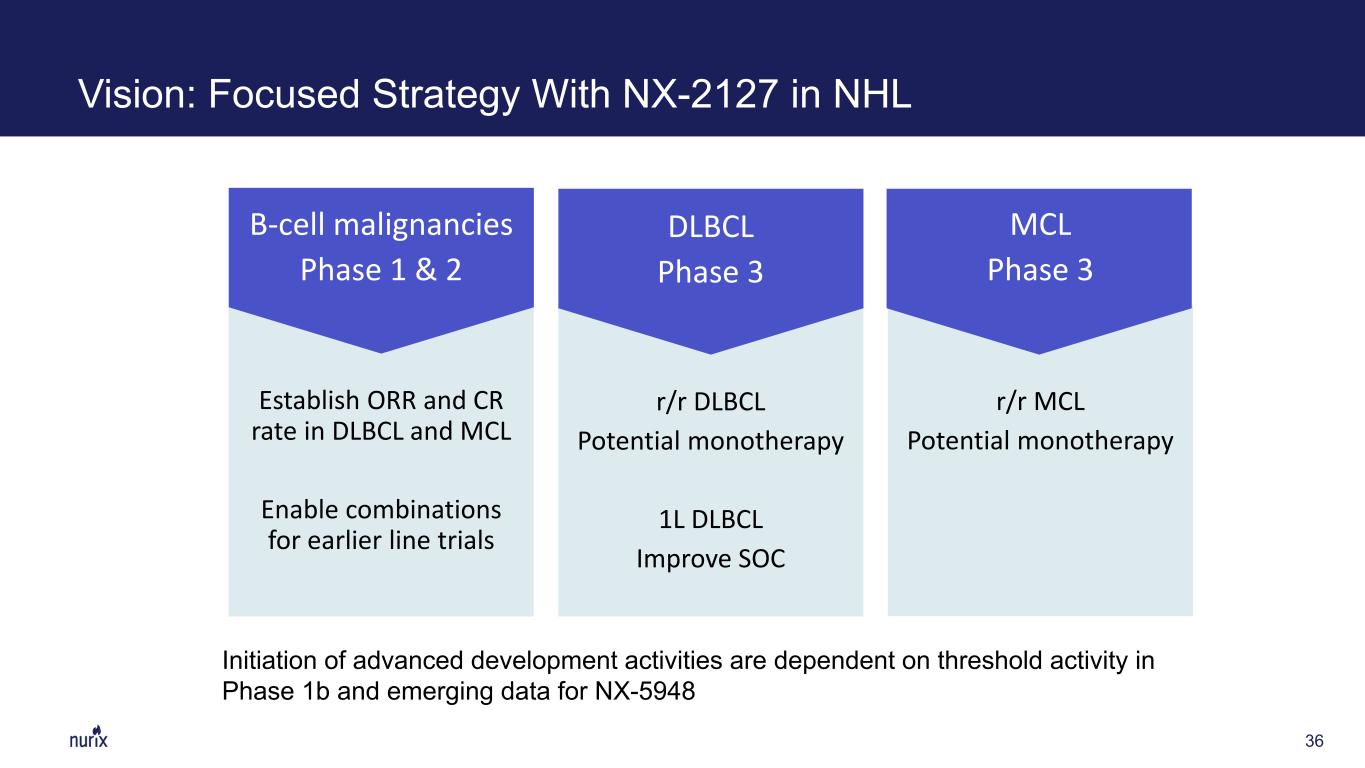
36 Vision: Focused Strategy With NX-2127 in NHL Initiation of advanced development activities are dependent on threshold activity in Phase 1b and emerging data for NX-5948 Establish ORR and CR rate in DLBCL and MCL Enable combinations for earlier line trials r/r DLBCL Potential monotherapy 1L DLBCL Improve SOC r/r MCL Potential monotherapy B-cell malignancies Phase 1 & 2 DLBCL Phase 3 MCL Phase 3

Targeting CBL-B Enhances Antitumor Response A Master Orchestrator of the Immune System 37 CBL-B TumorDCDying tumor Lymph node T cell Blood Tumor Dying tumor T cell NK cell CBL-B inhibition increases: • DC and NK infiltration and function • T cell priming • Cytotoxic T cells function • Ability of T cells to resist tumor immunosuppressive mechanisms: Treg, MDSC, and TGF-β CBL-B mediated mechanisms strongly restrains a productive anti-tumor response
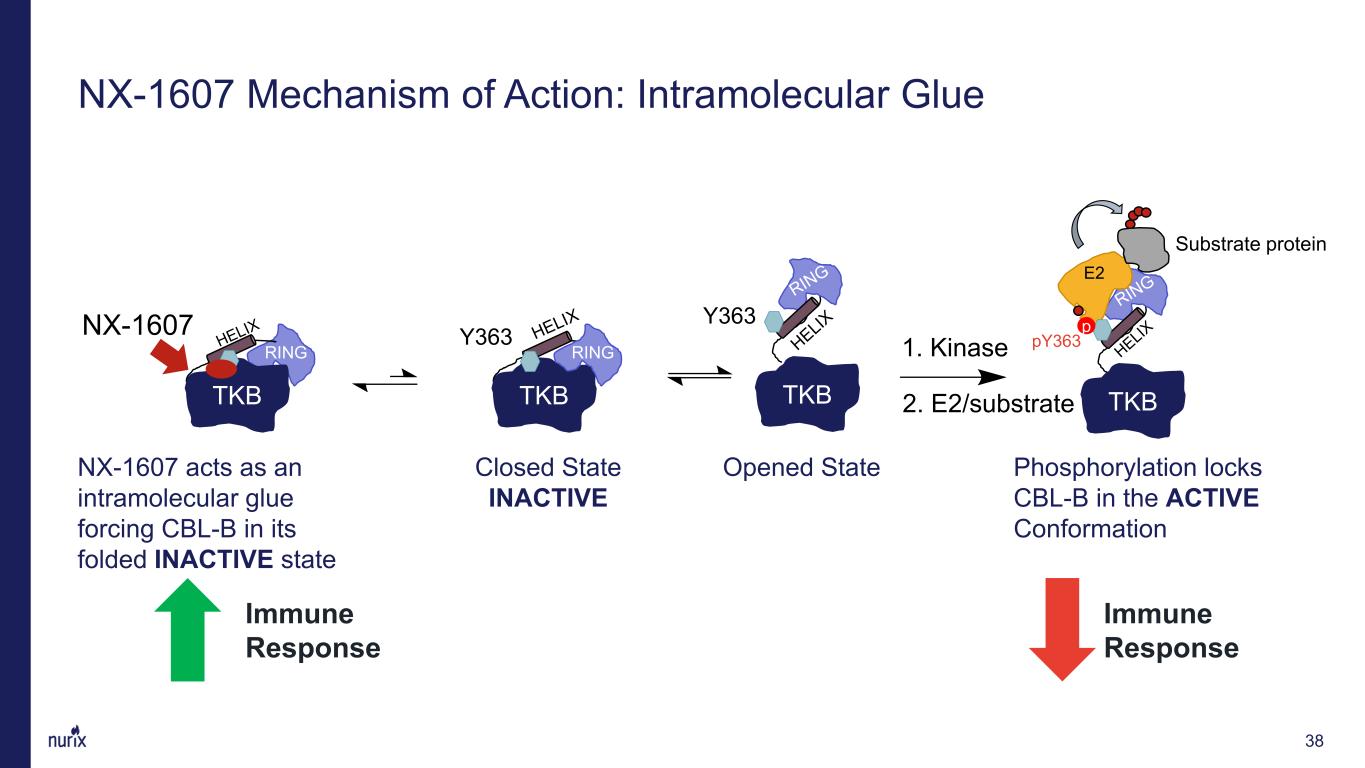
NX-1607 Mechanism of Action: Intramolecular Glue TKB RING Y363 Closed State INACTIVE TKB Y363 E2 TKB pY363 E2 Substrate protein 1. Kinase Phosphorylation locks CBL-B in the ACTIVE Conformation p 2. E2/substrate NX-1607 acts as an intramolecular glue forcing CBL-B in its folded INACTIVE state TKB RING NX-1607 Opened State Immune Response Immune Response 38
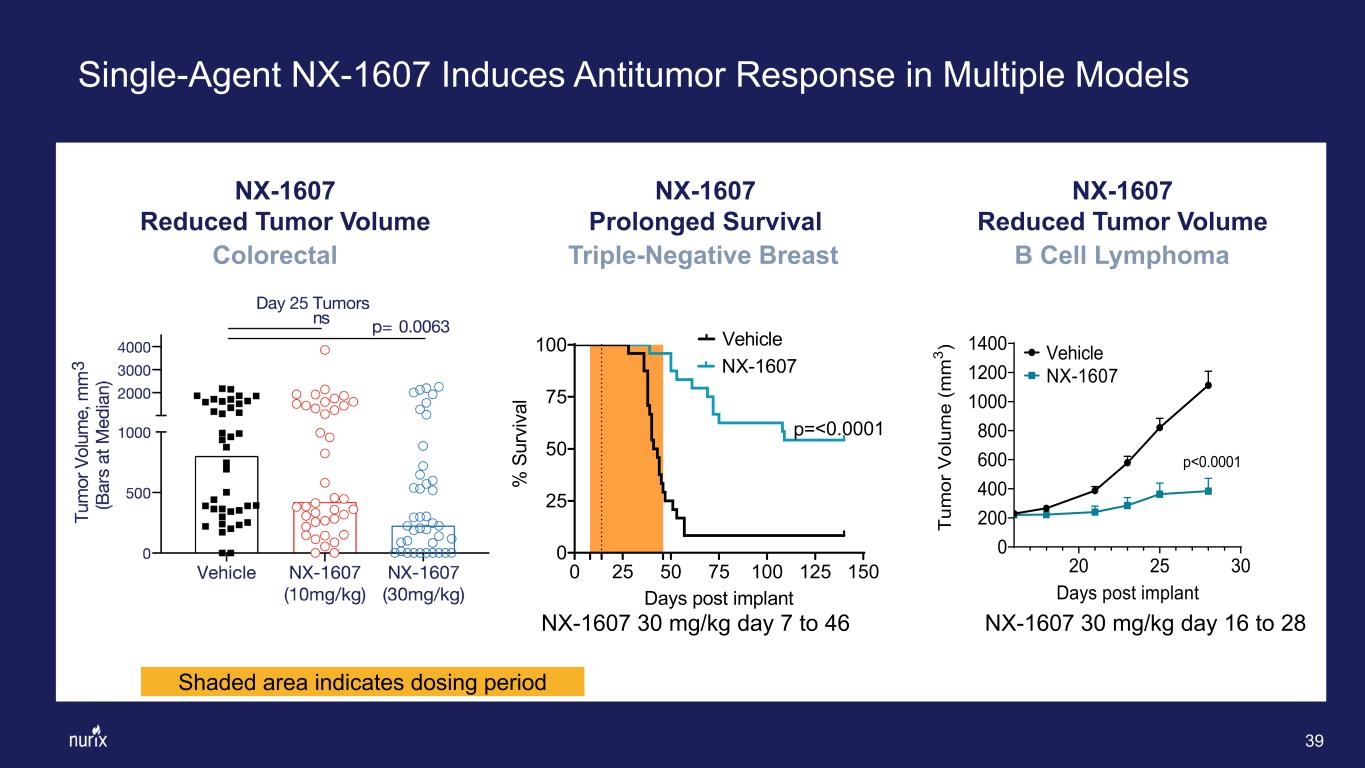
39 Single-Agent NX-1607 Induces Antitumor Response in Multiple Models NX-1607 Prolonged Survival NX-1607 Reduced Tumor Volume NX-1607 Reduced Tumor Volume NX-1607 30 mg/kg day 7 to 46 NX-1607 30 mg/kg day 16 to 28 Colorectal Triple-Negative Breast B Cell Lymphoma Shaded area indicates dosing period 0 25 50 75 100 125 150 0 25 50 75 100 Days post implant % S ur vi va l Vehicle NX-1607 <0.0001p= 20 25 30 0 200 400 600 800 1000 1200 1400 Days post implant Tu m or V ol um e (m m 3 ) NX-1607 Vehicle p<0.0001

NX-1607 and Anti-PD-1 Synergize to Enhance Anti-Tumor Effects and Survival of Mice in Multiple Tumor Models Colorectal (CT26) Triple-Negative Breast (4T1) Shaded area indicates dosing period: NX-1607 (30 mg/kg, PO daily) and anti-PD-1 twice a week at 10 mg/kg dosing period Colorectal (MC38) 40 Vehicle NX-1607 anti-PD-1 NX-1607+anti-PD-1 0 100 200 5000 10000 15000 Day 28 4T1 Lung Metastases # M et as ta tic C ol on ie s p<0.01 p<0.01
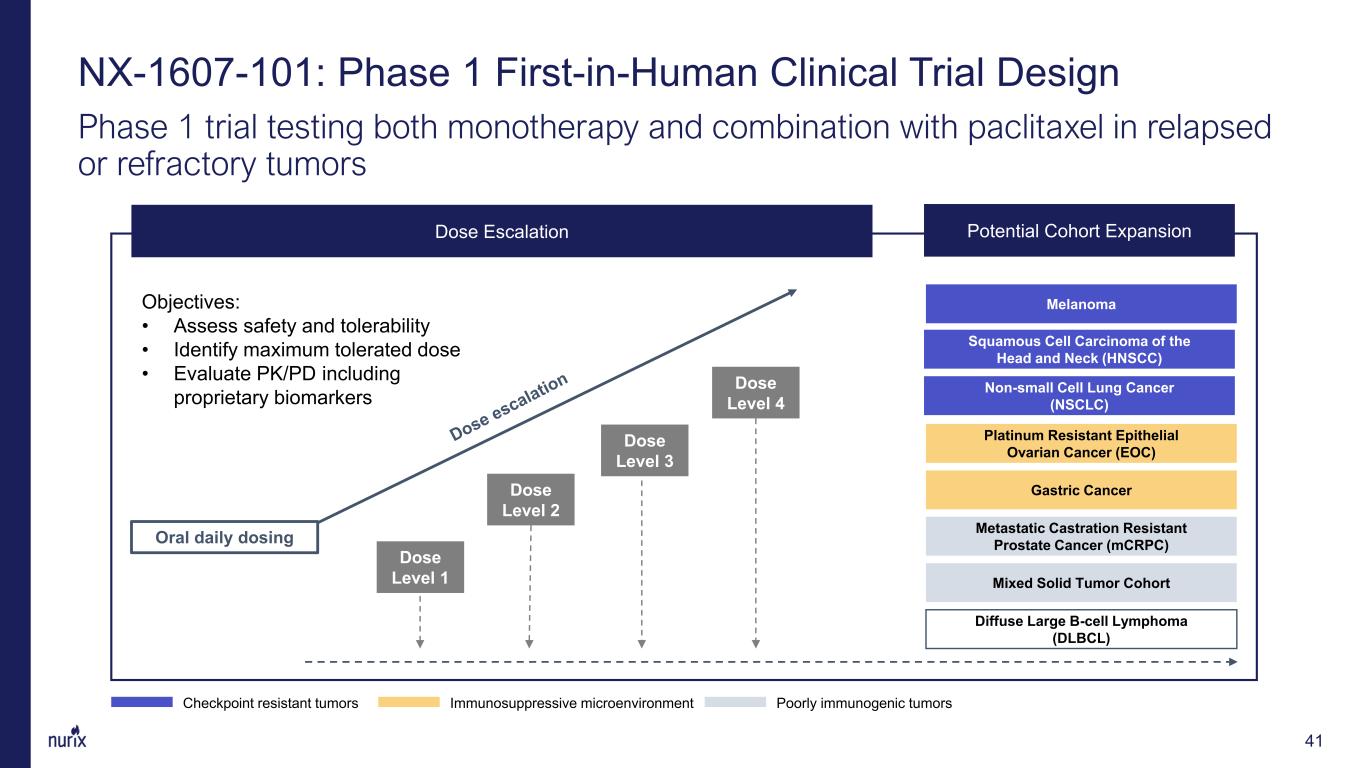
NX-1607-101: Phase 1 First-in-Human Clinical Trial Design Phase 1 trial testing both monotherapy and combination with paclitaxel in relapsed or refractory tumors Dose Escalation Potential Cohort Expansion Melanoma Platinum Resistant Epithelial Ovarian Cancer (EOC) Gastric Cancer Squamous Cell Carcinoma of the Head and Neck (HNSCC) Non-small Cell Lung Cancer (NSCLC) Objectives: • Assess safety and tolerability • Identify maximum tolerated dose • Evaluate PK/PD including proprietary biomarkers Oral daily dosing Dose Level 1 Dose Level 2 Dose Level 3 Dose Level 4 Metastatic Castration Resistant Prostate Cancer (mCRPC) Mixed Solid Tumor Cohort Diffuse Large B-cell Lymphoma (DLBCL) Checkpoint resistant tumors Immunosuppressive microenvironment Poorly immunogenic tumors 41
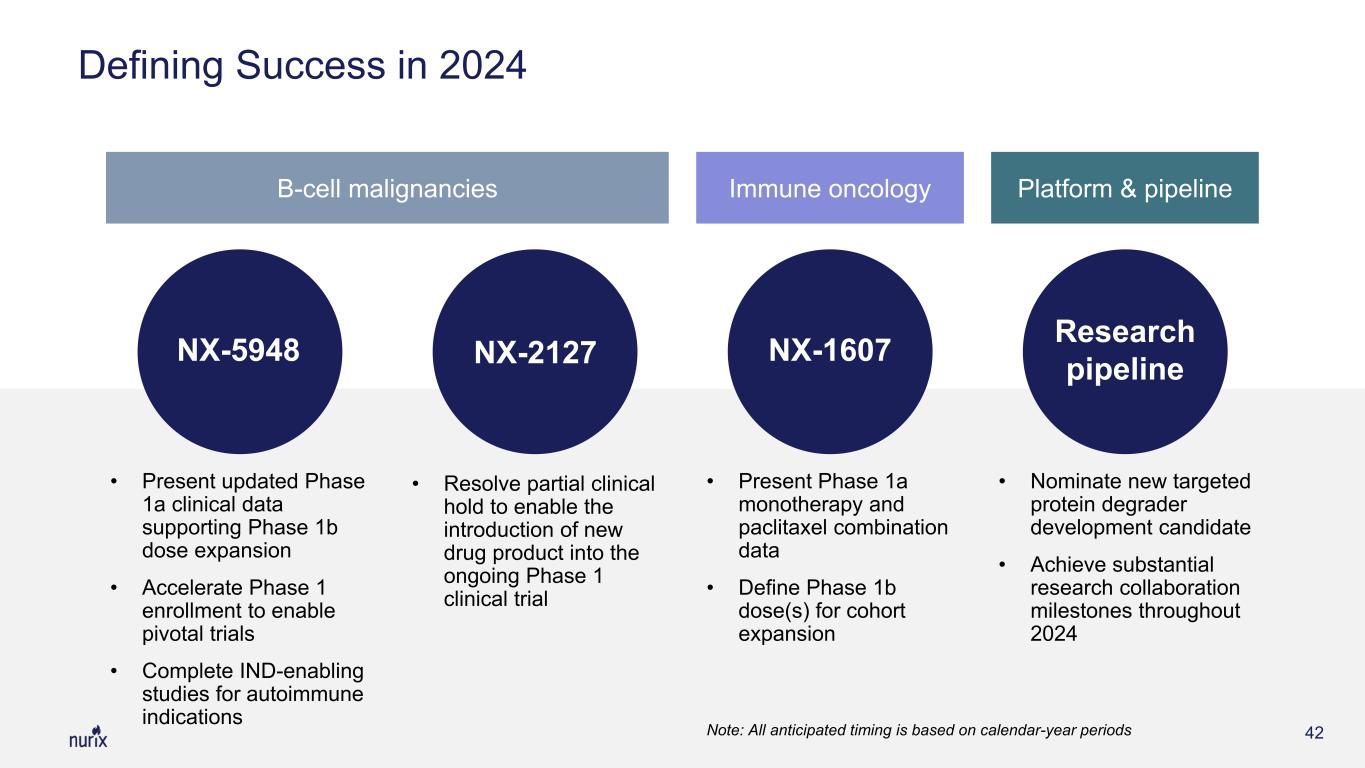
42 NX-5948 NX-1607 Research pipeline Note: All anticipated timing is based on calendar-year periods • Present updated Phase 1a clinical data supporting Phase 1b dose expansion • Accelerate Phase 1 enrollment to enable pivotal trials • Complete IND-enabling studies for autoimmune indications • Present Phase 1a monotherapy and paclitaxel combination data • Define Phase 1b dose(s) for cohort expansion • Nominate new targeted protein degrader development candidate • Achieve substantial research collaboration milestones throughout 2024 Defining Success in 2024 B-cell malignancies Immune oncology Platform & pipeline NX-2127 • Resolve partial clinical hold to enable the introduction of new drug product into the ongoing Phase 1 clinical trial
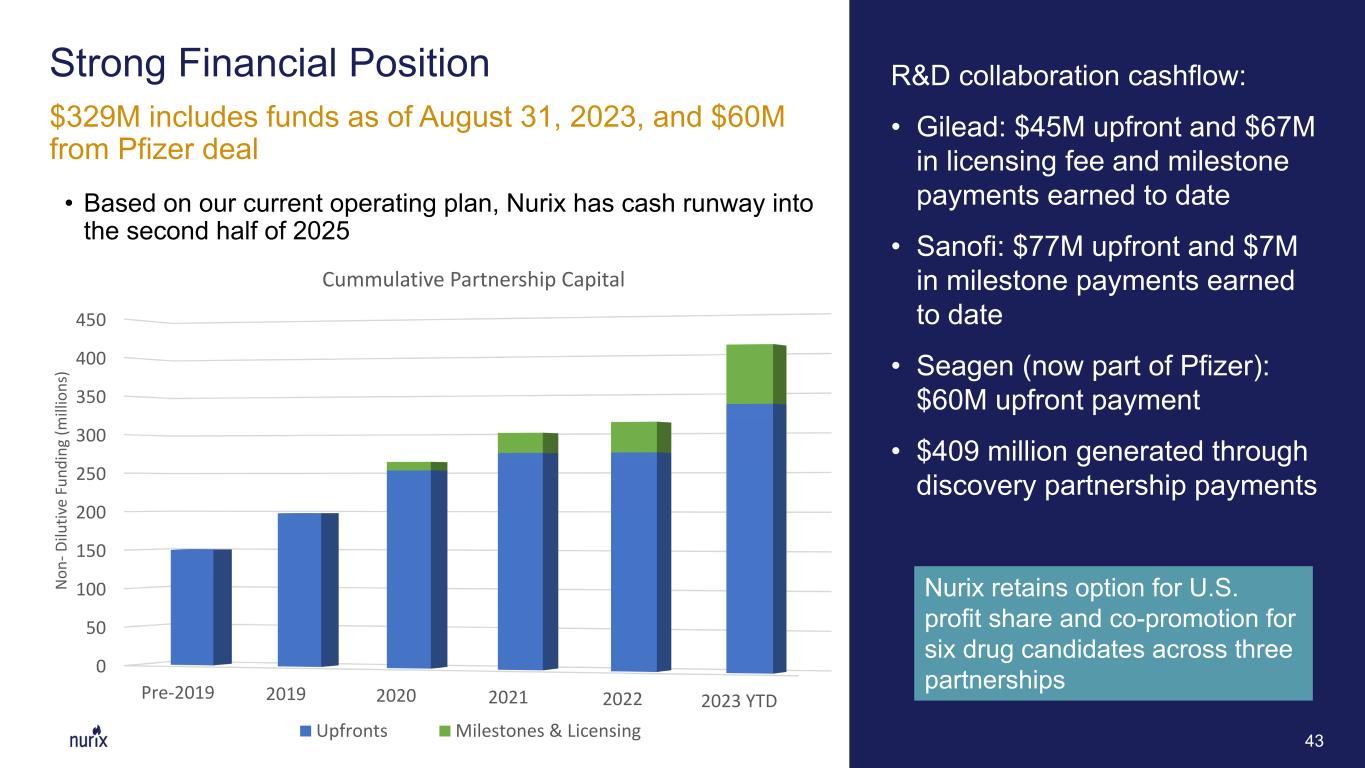
Strong Financial Position $329M includes funds as of August 31, 2023, and $60M from Pfizer deal R&D collaboration cashflow: • Gilead: $45M upfront and $67M in licensing fee and milestone payments earned to date • Sanofi: $77M upfront and $7M in milestone payments earned to date • Seagen (now part of Pfizer): $60M upfront payment • $409 million generated through discovery partnership payments • Based on our current operating plan, Nurix has cash runway into the second half of 2025 43 Nurix retains option for U.S. profit share and co-promotion for six drug candidates across three partnerships0 50 100 150 200 250 300 350 400 450 Pre-2019 2019 2020 2021 2022 2023 YTD N on - D ilu tiv e Fu nd in g (m ill io ns ) Cummulative Partnership Capital Upfronts Milestones & Licensing

Thank you











































